Few living arts invite the same blend of patience, precision, and quiet wonder as cultivating a bonsai garden. Whether you tend a single pine on an apartment balcony or curate dozens across a backyard, every miniature tree asks you to slow down and see the world on its own elegant scale. Over time, these tiny forests reveal lessons about climate, rhythm, and resilience that ordinary landscaping often misses. Ready to shape a space that doubles as an outdoor gallery and a calm retreat? Lean into the following bonsai garden ideas and discover how small trees can transform the whole atmosphere.
1. Tiered Bench Displays Elevate Bonsai at Varying Heights
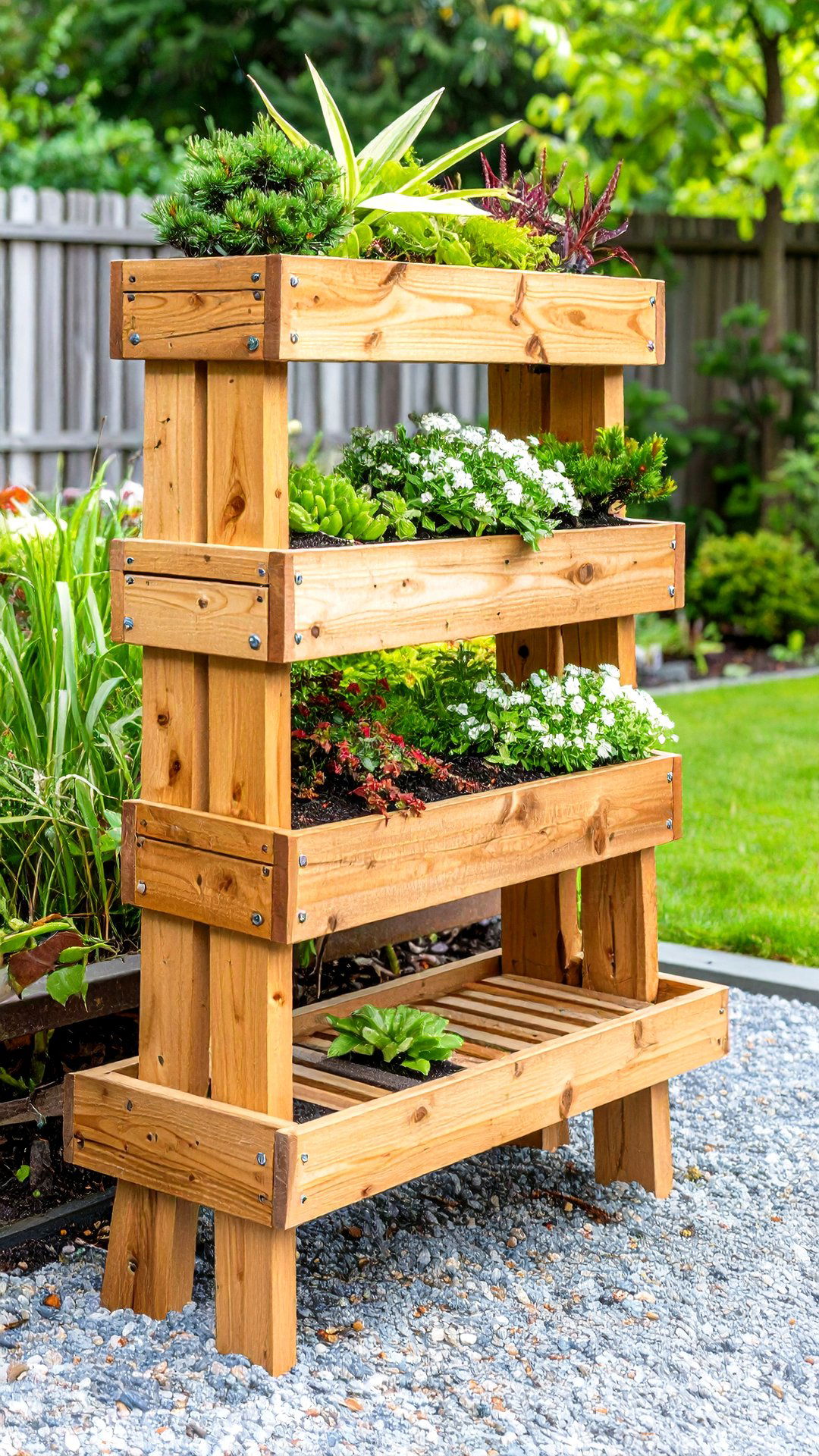
A well-built tiered bench instantly multiplies the drama of a bonsai garden by stacking trees at staggered eye levels. Start with rot-resistant lumber such as cedar, adding galvanized screws to withstand humidity. Position shorter specimens like dwarf jade on the lowest shelf and taller pines up top so every canopy receives sunlight without casting heavy shade. The stepped design encourages depth perception, helping viewers appreciate bark texture and nebari roots from multiple angles. Include narrow gaps between slats for drainage, and angle the entire structure one degree forward to shed rainwater quickly. Periodic sanding and linseed oil protect the benches year-round.
2. Natural Stone Slabs Become Rugged Bonsai Plinths
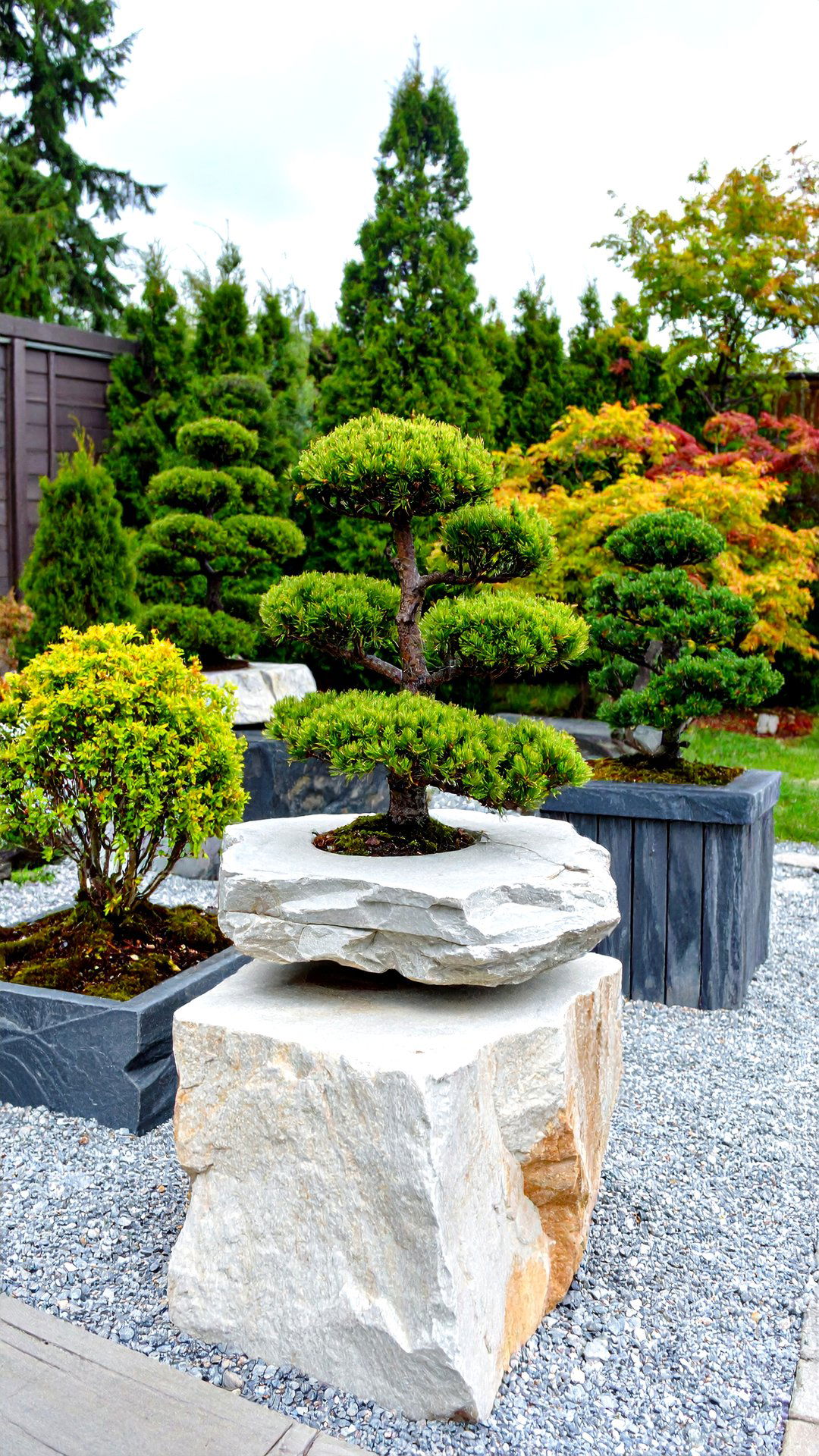
Unlike wooden stands that can warp, rough-cut limestone or granite slabs provide weighty stability while echoing mountain crags — the very landscapes many bonsai mimic. Source off-cuts from a masonry yard, then set each slab on compacted gravel so water drains freely. Arrange evergreens with windswept styling on pale stones to highlight trunk curves, and contrast deciduous maples against darker slate to accentuate autumn foliage. Stones also moderate soil temperature, keeping roots cooler in hot weather. Wipe algae buildup gently with a nylon brush once a season; harsh cleaners can leach into pots. Over time, lichens may colonize edges, adding authentic patina.
3. A Shallow Reflecting Pool Doubles Light and Serenity
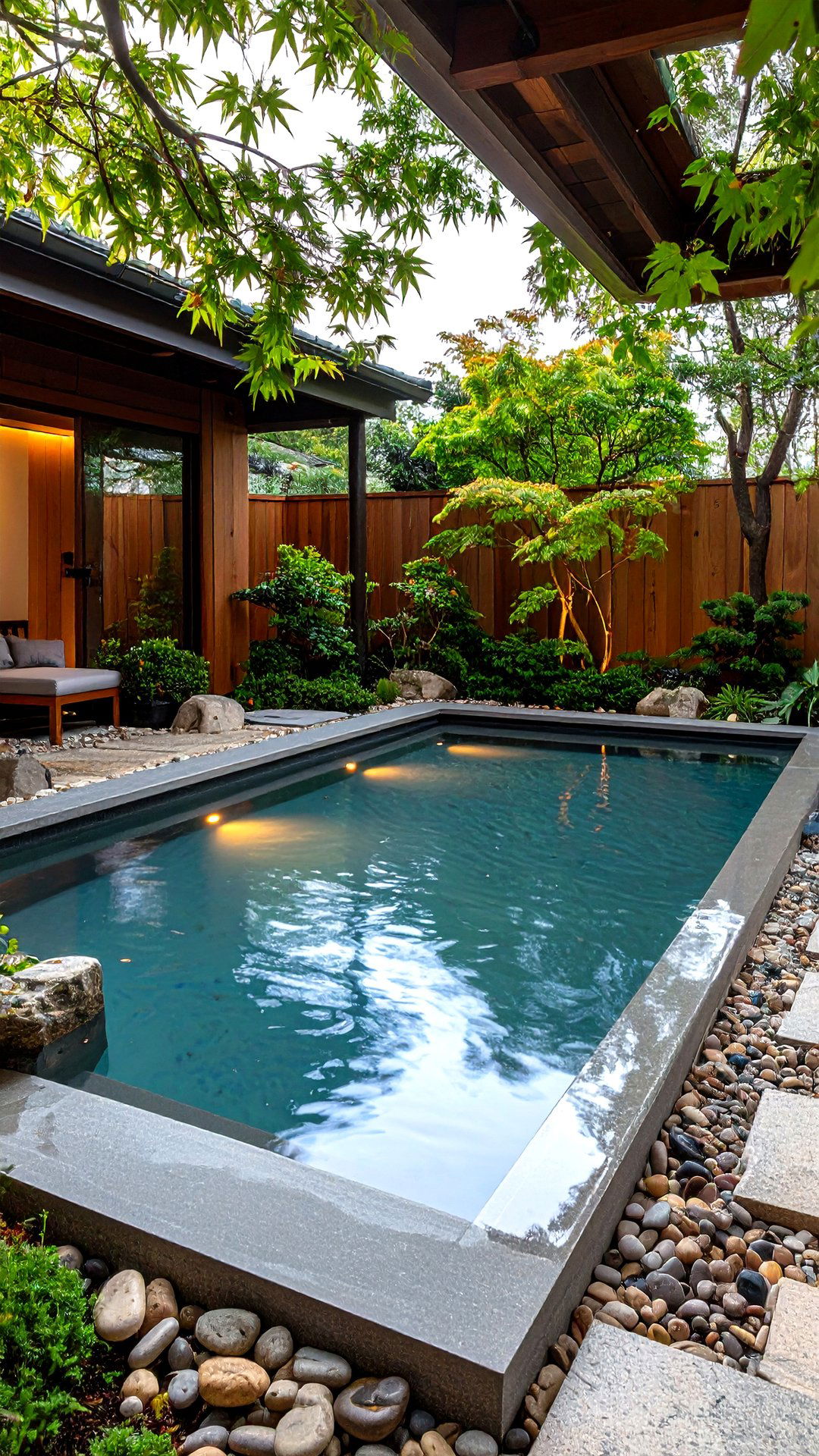
Few sights top the mirror-like surface of a quiet pond catching a bonsai’s silhouette. Excavate a basin just five centimeters deep, line it with EPDM rubber, and rim it with river pebbles for a natural finish. Place moisture-loving species such as Japanese maple nearby, letting leaf tips hover over the water to double color intensity. Solar-powered pumps maintain gentle circulation that discourages mosquitoes without agitating reflections. Avoid heavily chlorinated tap water — rain barrels supply softer reserves that keep mineral spots off pots. Evening uplights skimming the pool bring a moonlit atmosphere for night viewing sessions.
4. Bamboo Screens Frame Bonsai and Shield Harsh Winds
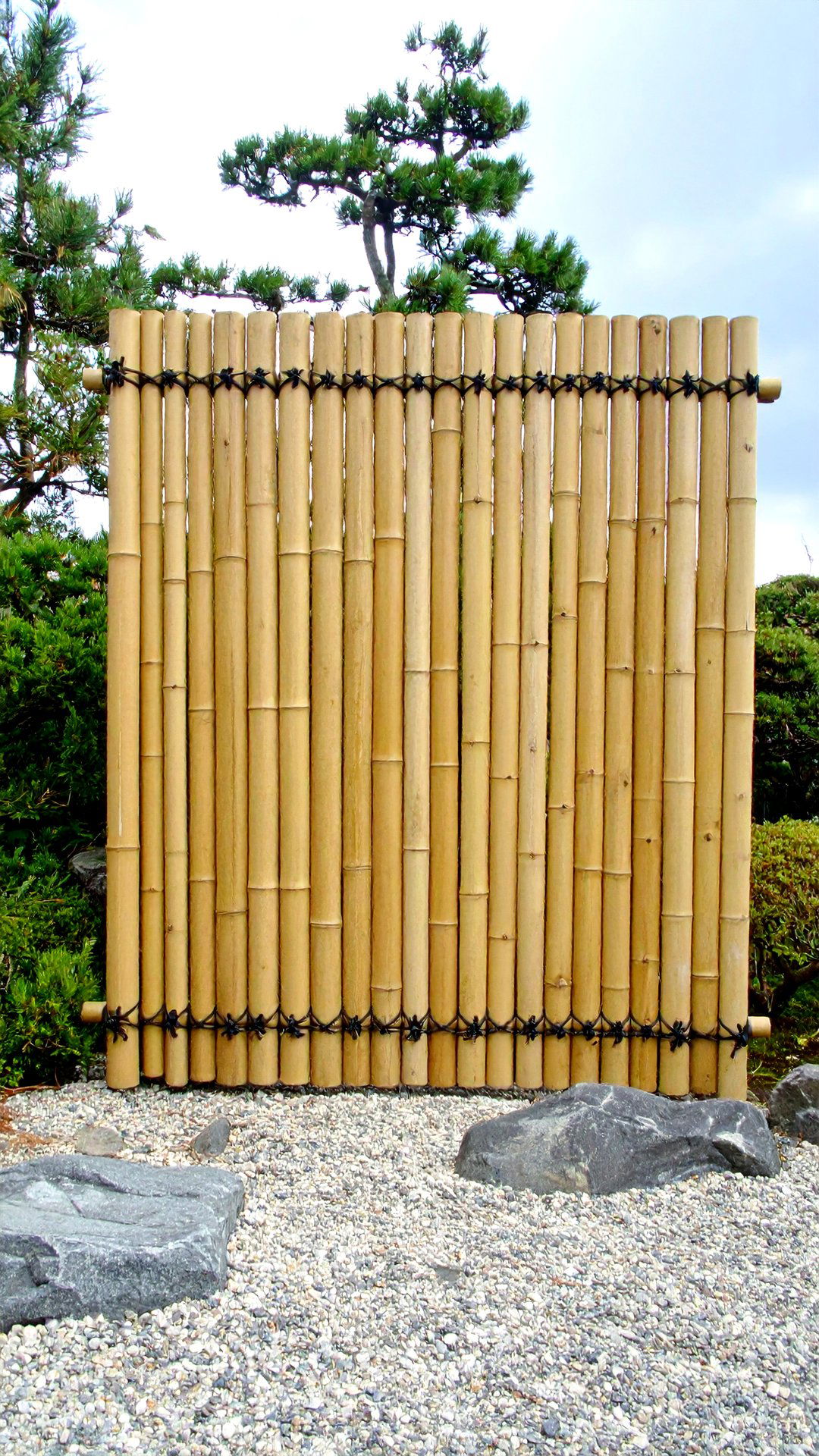
A thoughtfully placed bamboo lattice does more than nod to traditional Japanese gardens; it filters drying gusts that can desiccate miniature forests in minutes. Choose culms at least three centimeters thick for durability, lashed with dark jute twine to prevent metal rust streaks. Set the screen on the garden’s windward edge, tilting it five degrees backward for stability in storms. The warm, golden tone complements gray shari bark on junipers, while the open weave casts dappled shade that lowers leaf scorch risk at midday. Re-tighten bindings each spring, and treat bamboo with natural borax to deter insects.
5. Subtle Garden Lighting Extends Bonsai Enjoyment After Sunset
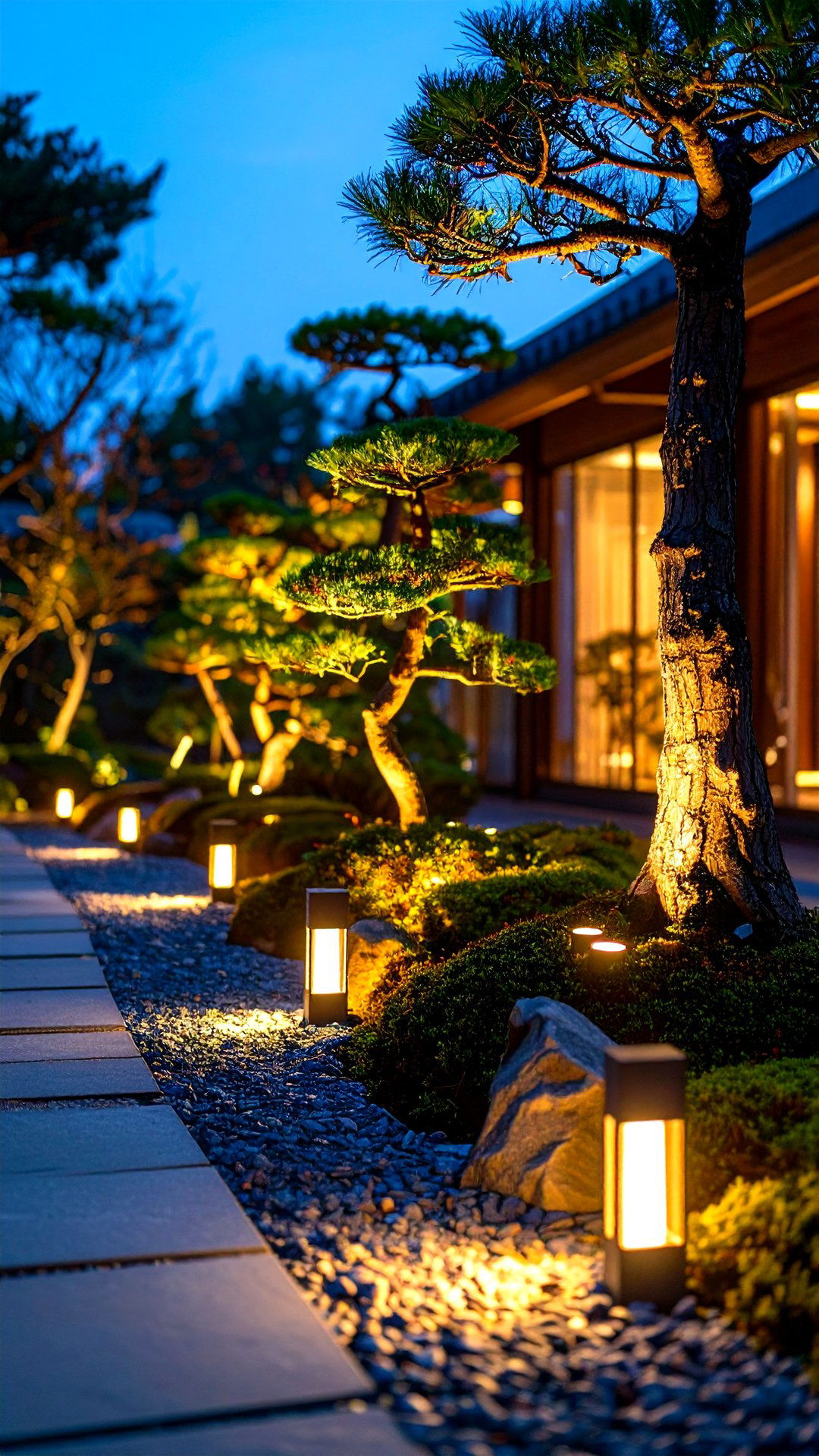
When dusk falls, soft lighting turns a collection into a contemplative night gallery. Install low-voltage LED spotlights at ground level, aiming upward to graze trunks and emphasize branch pads. Warm white bulbs (2700 – 3000 K) flatter green needles better than cool hues. Solar stakes risk dimming on cloudy days, so link wired fixtures to a timer that mimics sunrise and sunset times throughout the year. Position lights behind rather than in front of viewers to avoid glare. Clean lenses quarterly; dust buildup can cut brightness by 30 percent and skew color accuracy.
6. Seasonal Color Groupings Highlight Year-Round Interest
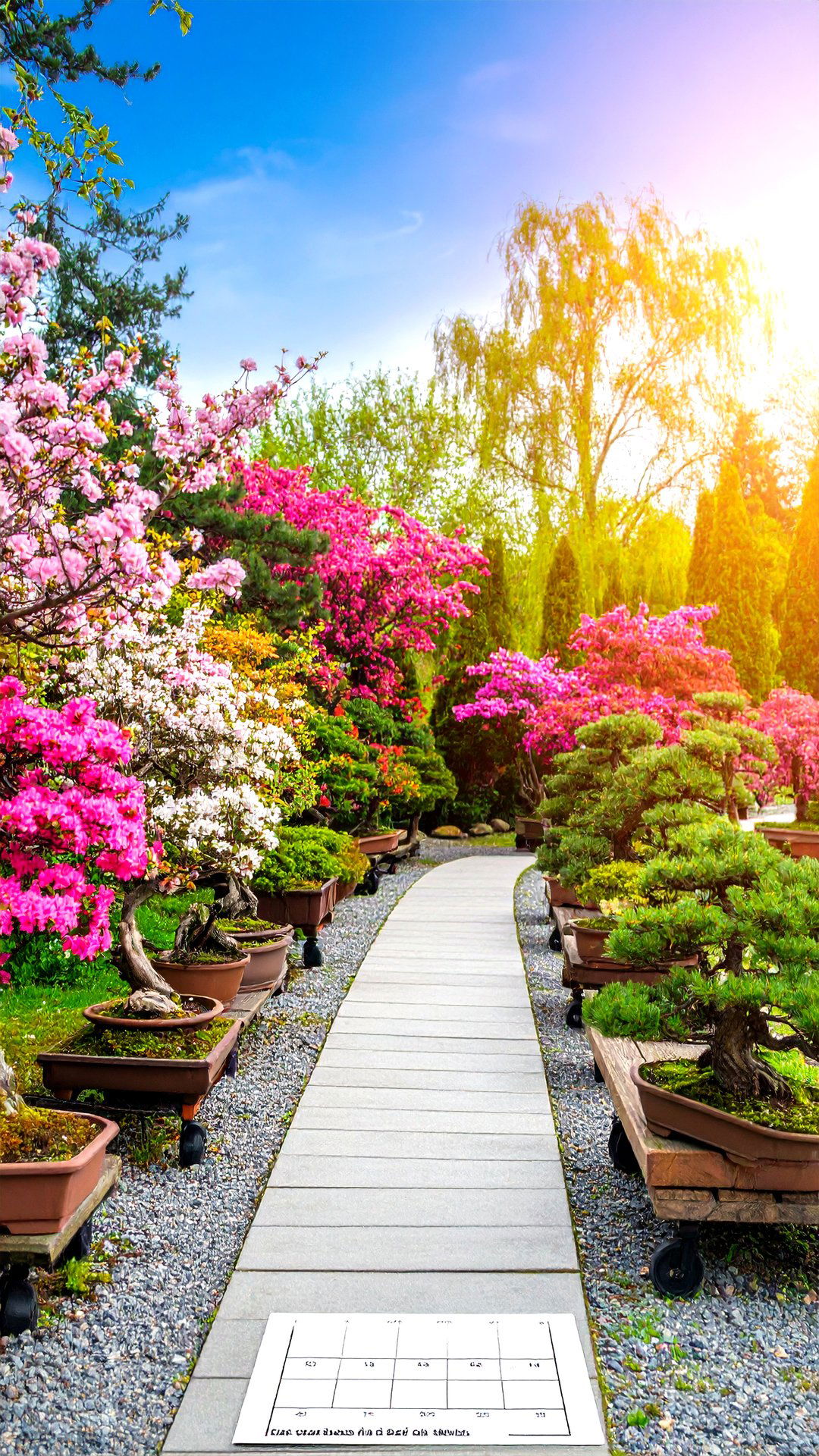
By clustering bonsai according to seasonal strengths, you ensure visual excitement no matter the month. Begin with early-flowering azalea and cherry near a path for spring appeal, shift to Japanese maple and larch for autumn reds, and reserve juniper or black pine for winter structure. Rotate pots on wheeled caddies so peak performers move front and center as their moment arrives. Keeping a simple spreadsheet of bloom times helps plan smooth transitions and avoids bare patches. This choreography also simplifies photo documentation, capturing each variety at its best for learning and sharing online.
7. A Mobile Bonsai Cart Simplifies Storm Protection
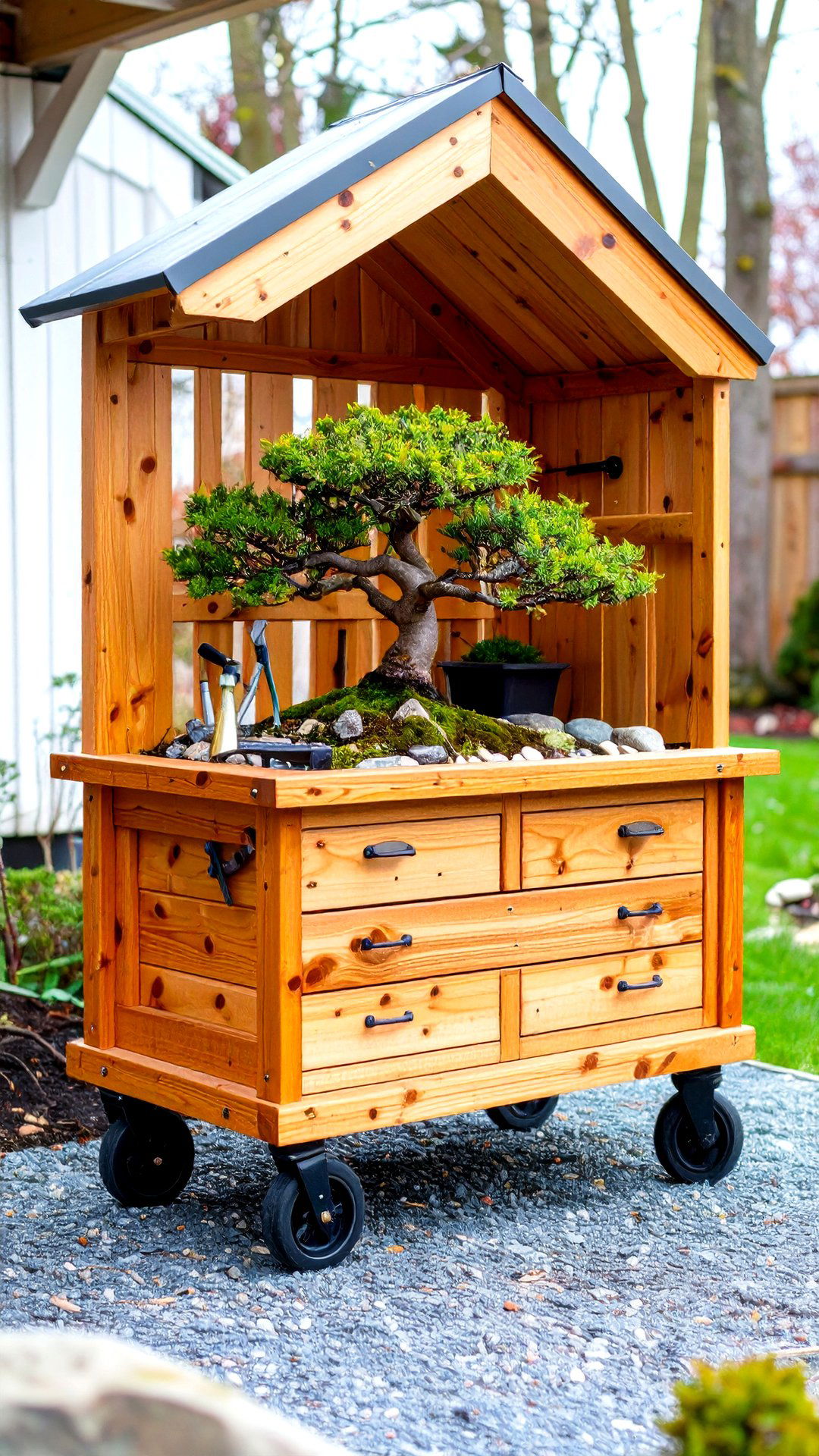
Sudden hail can undo years of diligent pruning, so a rolling cart becomes invaluable during extreme weather. Build a platform from marine plywood on heavy-duty casters rated for at least 200 kg, then affix locking brakes. Arrange trees by weight — high-rise literati styles inward, heavier root-over-rock styles along edges for ballast. When forecasts threaten, wheel the cart into a garage or under a patio roof within minutes. Between storms, the cart functions as a grooming station: keep shears, wire, and a spray bottle in a side drawer so routine maintenance stays organized and mobile.
8. A Mini Zen Sand Bed Invites Meditative Raking
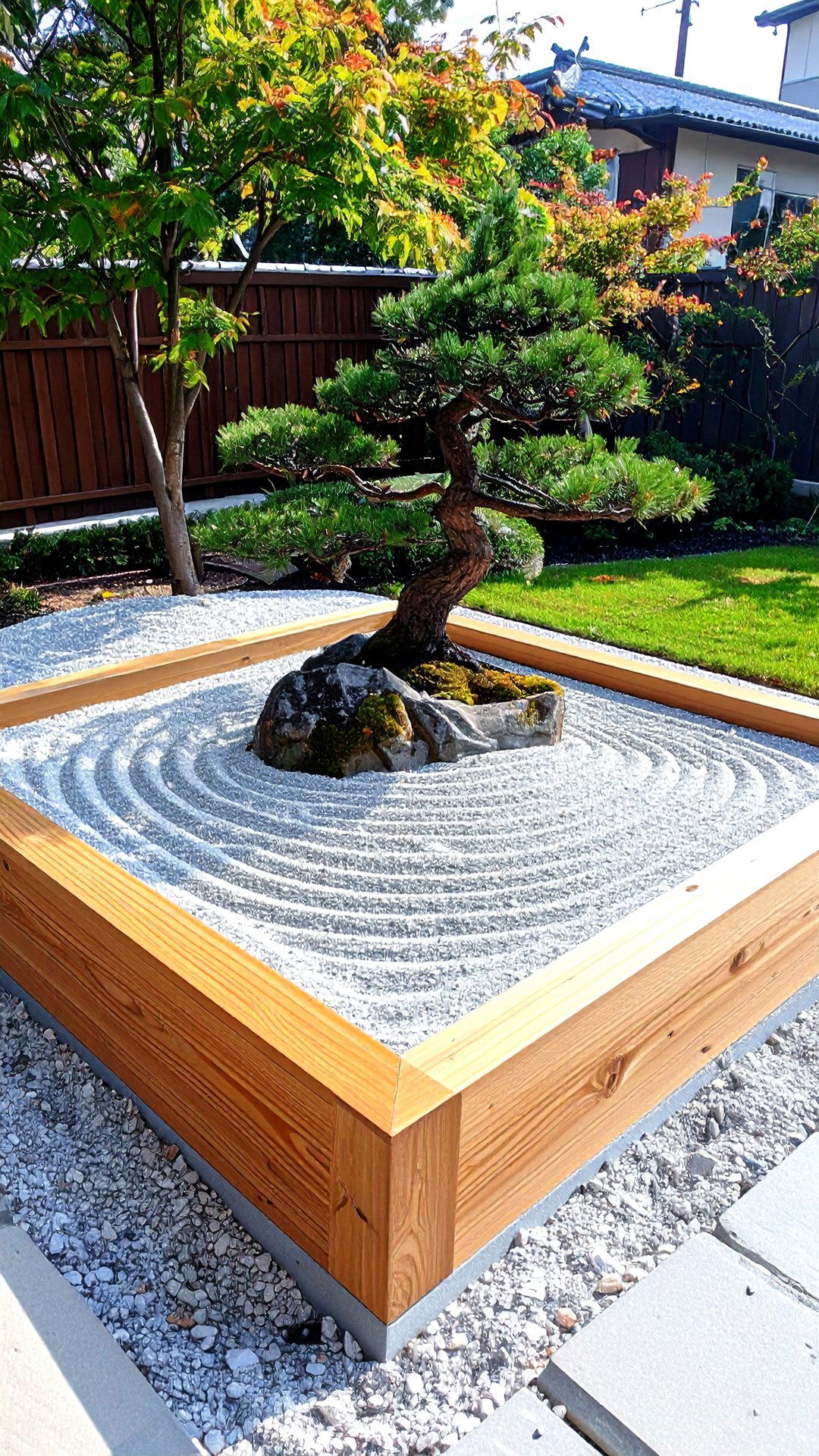
Spreading fine granite gravel beneath a bonsai pedestal introduces a dynamic art form of its own. Outline a rectangle with untreated cedar borders, fill to two centimeters deep, and smooth the surface with a teak trowel. Rake ripple patterns that echo ocean waves encircling an island tree; change designs weekly to refresh the scene. The pale substrate reflects light, brightening shaded corners of the garden. Brush stray grains off pots daily to prevent etching glazed finishes. Come monsoon season, tamp the sand lightly after rain to retain crisp lines and aid evaporation.
9. Native Species Corner Celebrates Local Ecology

Consider dedicating one section of the bonsai garden to trees collected or grown from seed in your own region. Juniperus communis and pistachio thrive in Pakistan’s dry zones, while Himalayan cedar suits cooler uplands. Native plantings acclimate faster, shrug off local pests, and teach deeper lessons about the surrounding ecosystem. Mount an engraved tag near each pot citing collection date and location to track provenance ethically. Sharing these stories with visitors fosters conservation awareness and discourages illegal wild harvesting. Consult forestry guidelines before collecting, ensuring sustainable methods and necessary permits are in place.
10. Wall-Mounted Shelf Systems Save Ground Space
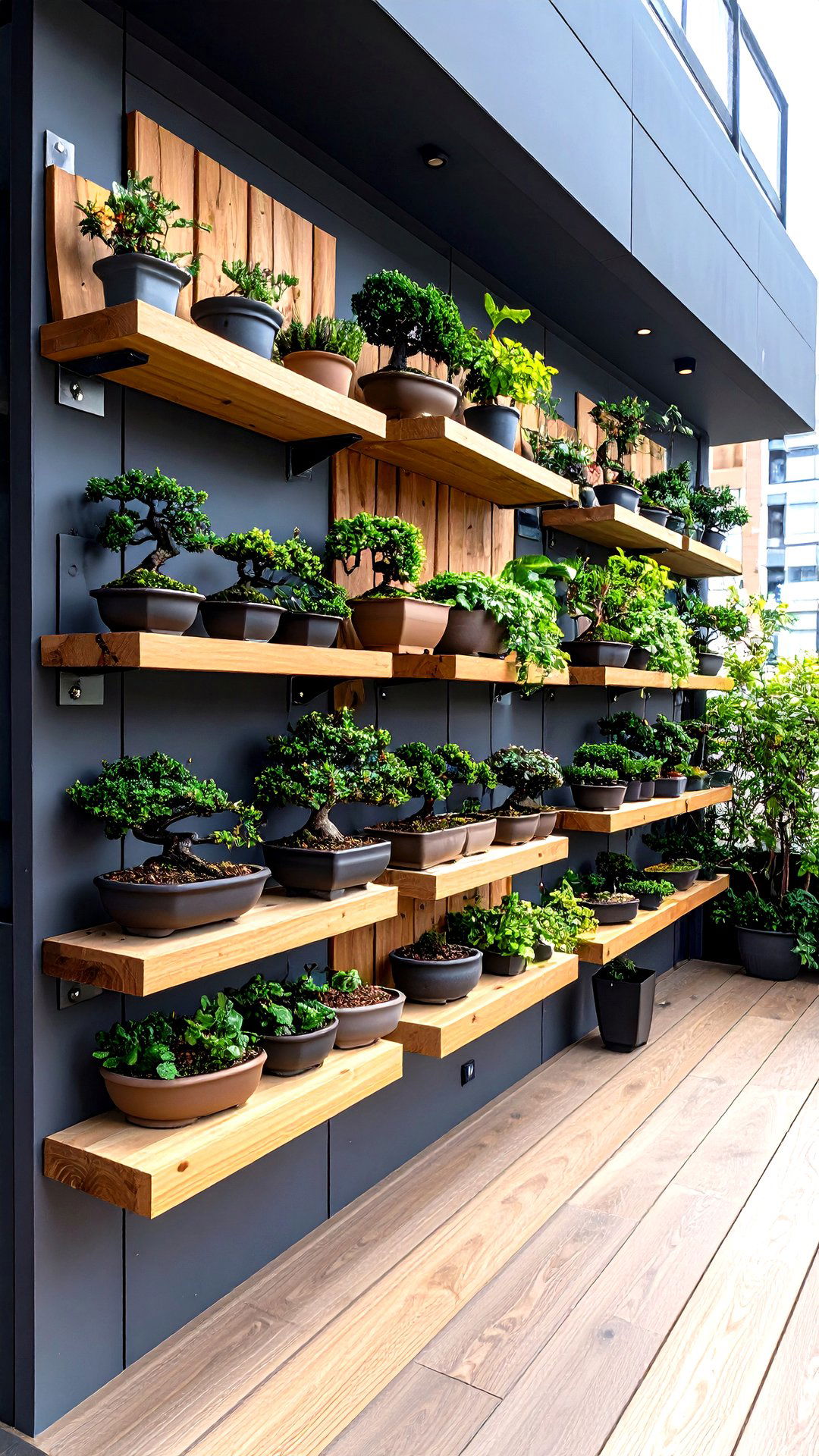
For urban balconies, galvanized steel brackets and weather-proofed cedar planks transform plain walls into vertical bonsai galleries. Space shelves at least 45 centimeters apart so foliage doesn’t brush stucco, promoting air circulation and reducing fungal risk. Bolt brackets into masonry anchors capable of bearing 30 kg each; clay pots saturated after rain get heavy. Paint the wall a matte charcoal — experts note dark backdrops sharpen silhouette outlines at photo time. Incorporate drip trays lined with coconut coir to absorb overflow and protect neighbors’ balconies below. Inspect hardware seasonally for rust, swapping bolts as needed.
11. Moss Carpets Add Lush Understory and Moisture Buffer
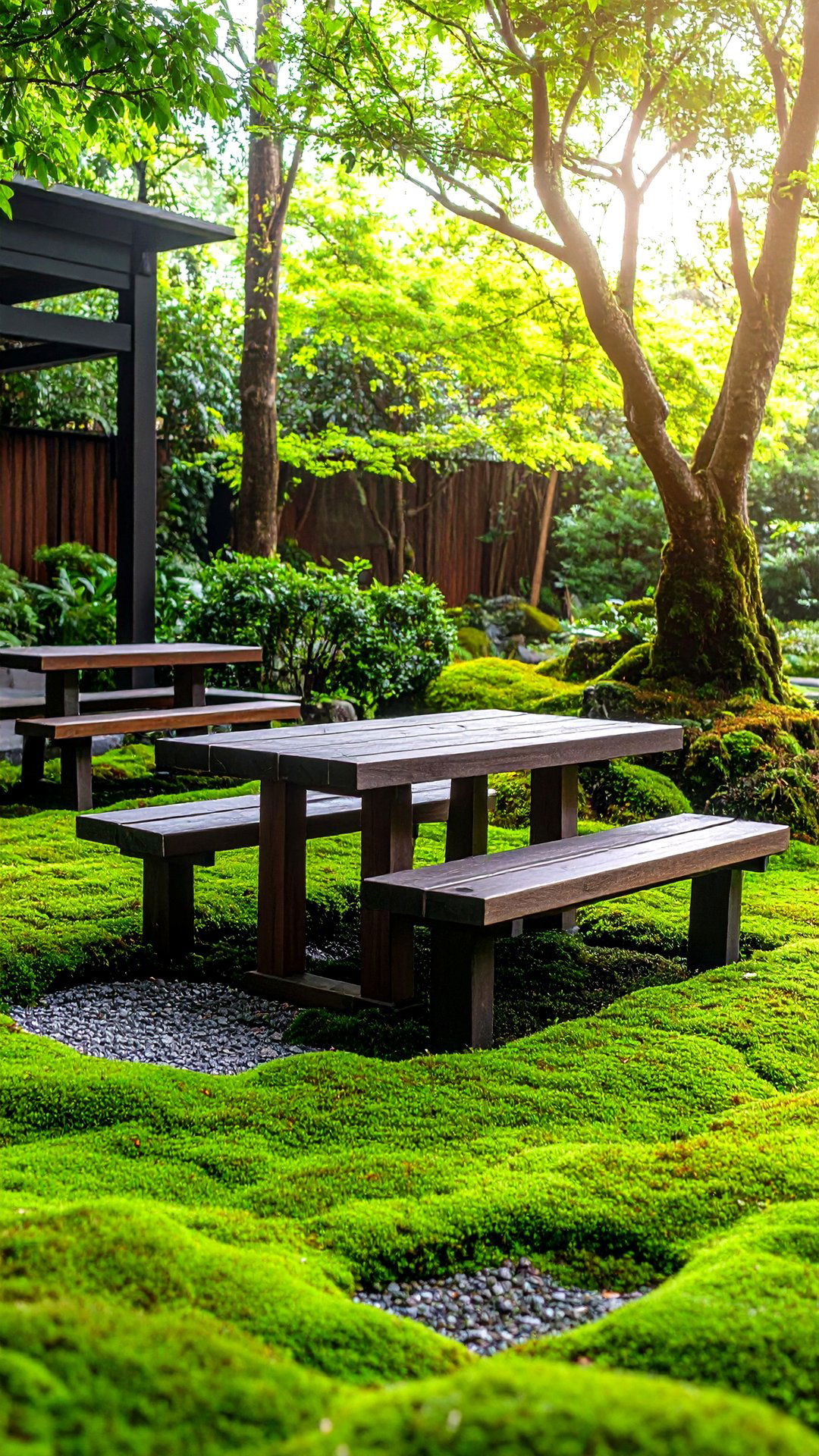
Laying sheets of sphagnum or Hypnum moss at the foot of display stands instantly softens hardscapes while holding humidity around shallow pots. Soak moss overnight, then press it onto lightly shaded soil between benches. The emerald carpet curbs dust, muffles footfall noise, and visually anchors tiny forests within a verdant “forest floor. ” Mist morning and evening during dry spells, but lift portions weekly to ensure no anaerobic slime forms underneath. Replace browned sections with fresh trimmings, and thin aggressively where moss threatens to creep into drainage holes of pots.
12. A Meandering Stone Path Guides Viewers Through Vignettes
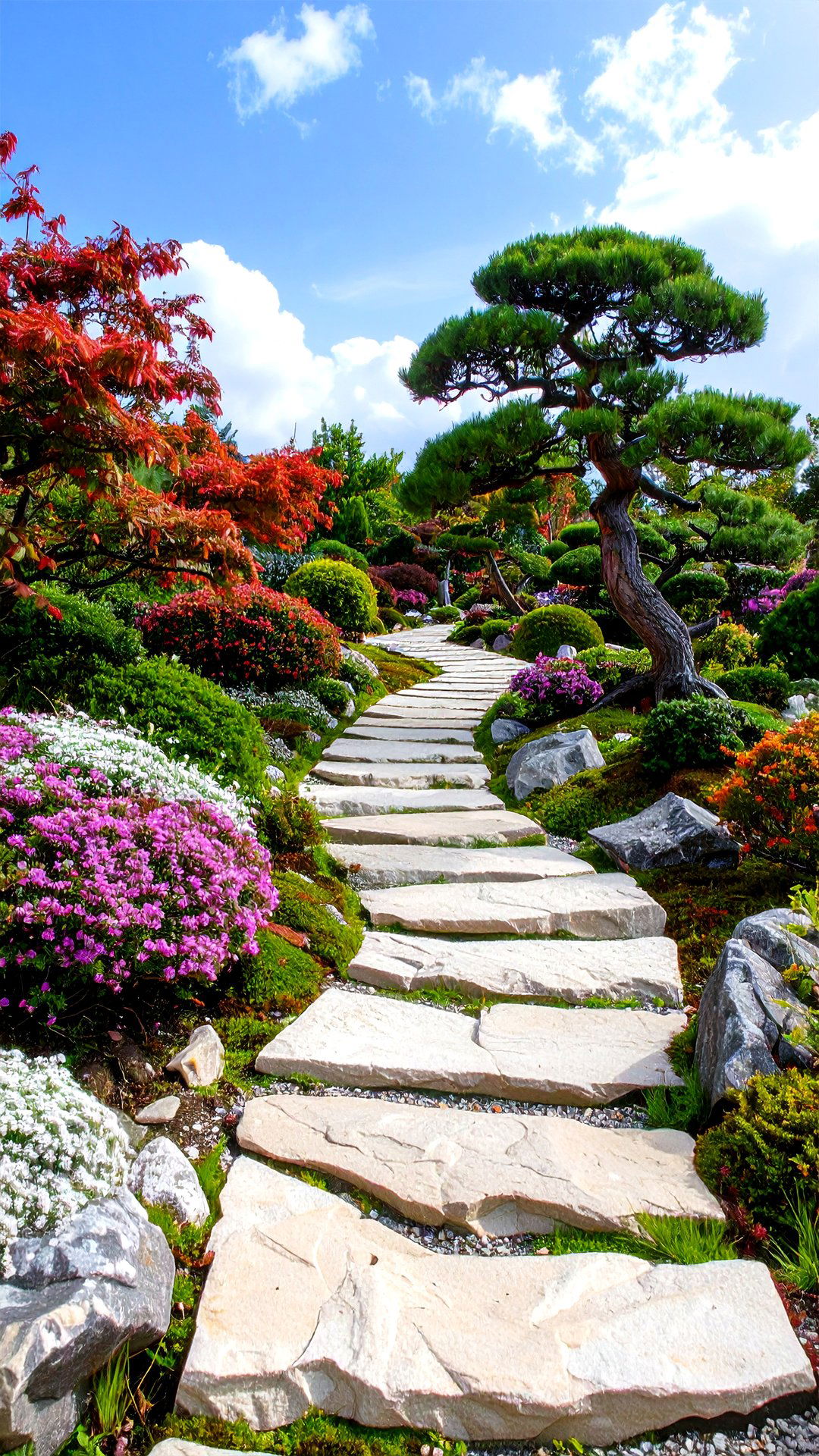
Designing a curved flagstone walkway encourages slow pacing and shifting perspectives as visitors discover each bonsai tableau. Lay irregular sandstone in a serpentine route approximately 80 centimeters wide — enough for two people to walk side-by-side. Keep edges loose, allowing thyme or baby’s tears to spill over joints for an organic look. Position displays at slight angles to the path so trunks reveal new contours mid-stride. Integrate a subtle rise or step every few meters; elevating vantage points leads the eye from canopy to nebari, deepening appreciation for proportion and taper.
13. Weathered Driftwood Adds Sculptural Contrast
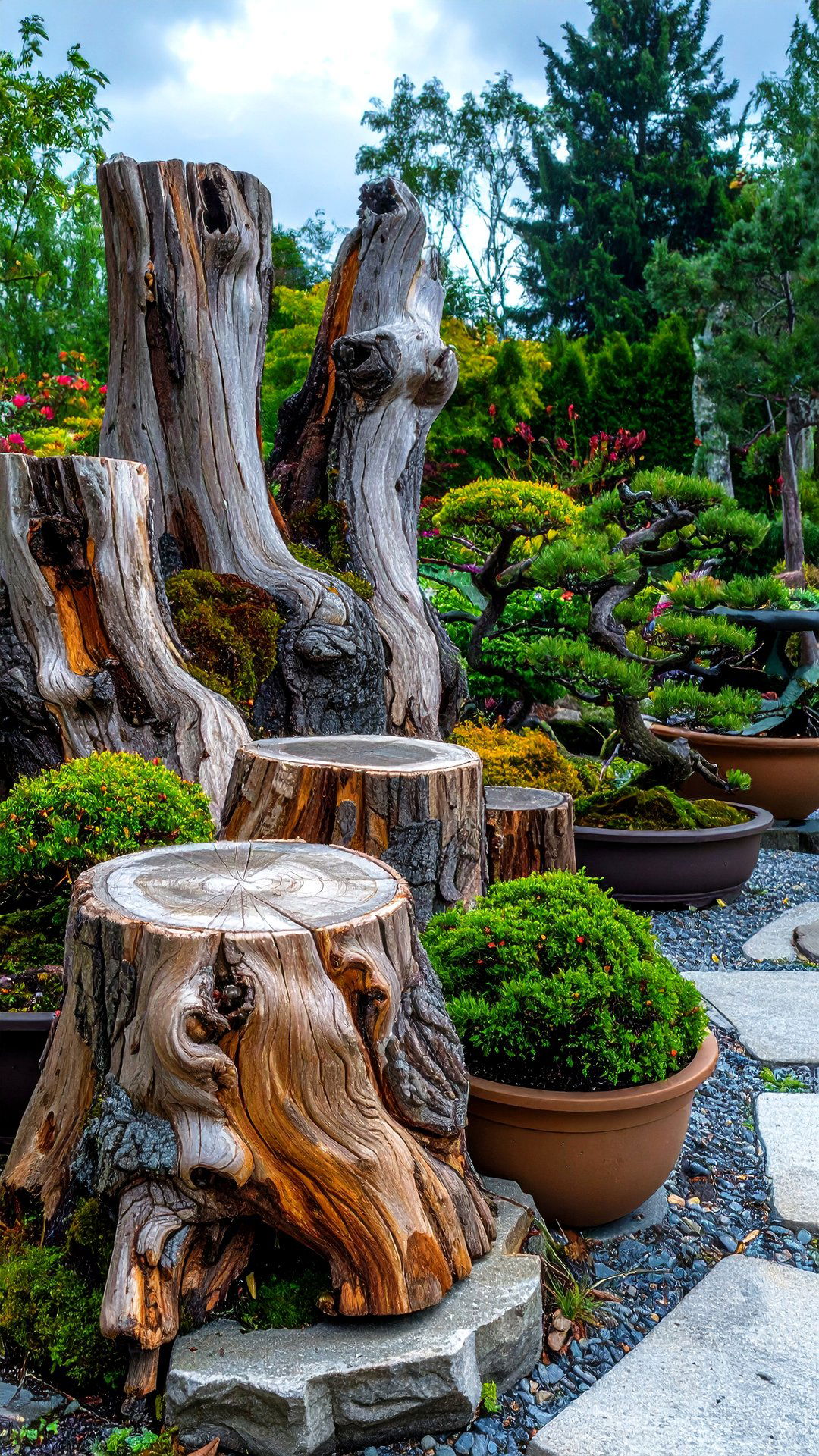
Introducing sun-bleached driftwood stumps beside pots provides a dialogue between living and dead wood. Choose pieces with twisted grain and smooth hollows, echoing jin techniques on conifers. Anchor each fragment on a buried concrete footing to prevent tipping, and treat with clear wood preservative to resist termites. Over time, lichens naturally colonize the surface, harmonizing with aged bark. Lighting driftwood from below at night casts dramatic shadows over foliage, enriching evening ambiance. Resist the urge to overpopulate; two or three statement pieces maintain balance without cluttering sightlines.
14. A Rotating Turntable Stage Aids Display and Maintenance
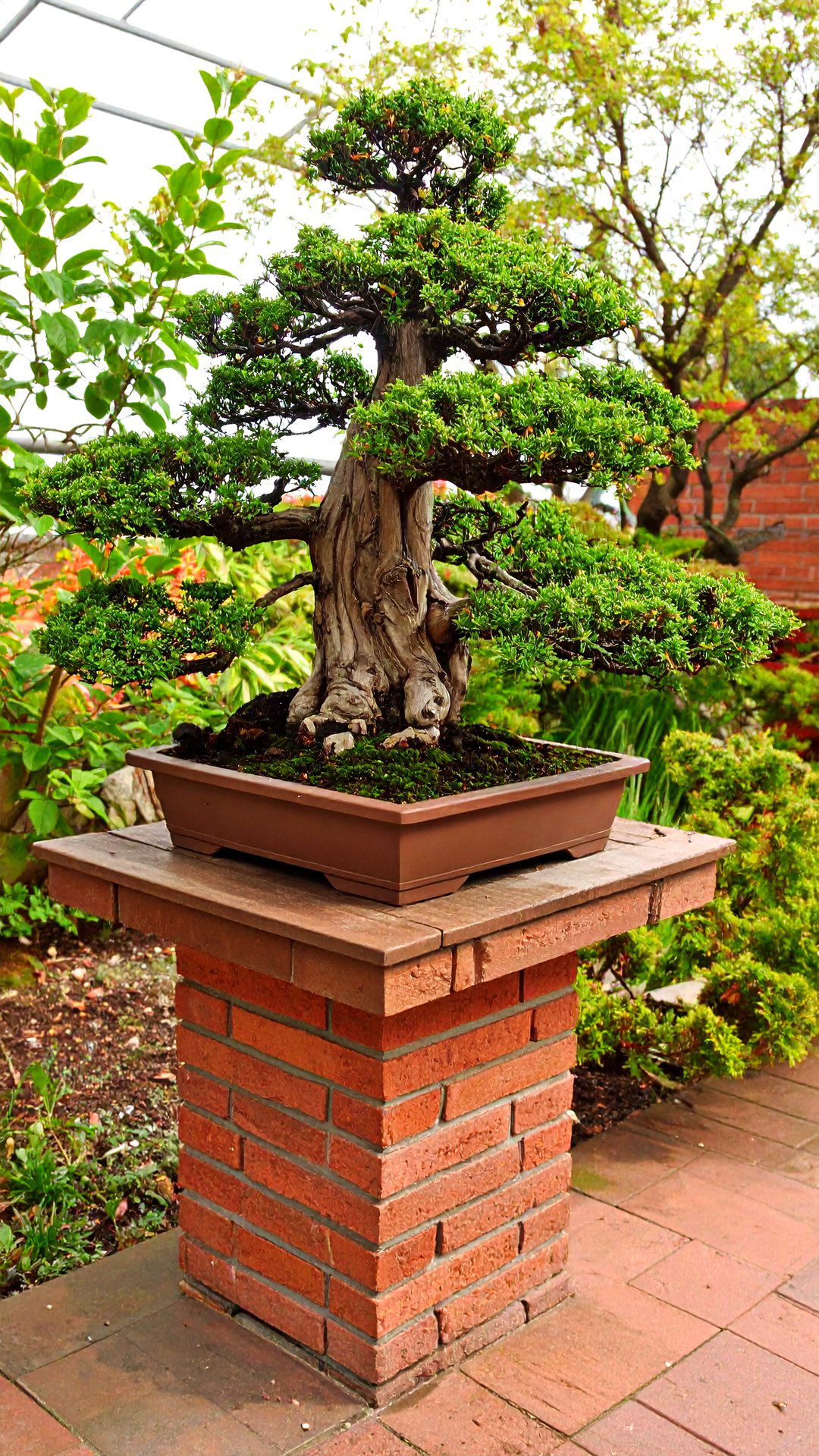
Placing prized specimens on a sturdy lazy Susan — sealed ball-bearing models sold for pottery wheels work well — lets you showcase every side without lifting heavy pots. Embed the turntable into a recessed brick plinth at waist height to keep silhouettes stable in wind. Daily quarter-turns promote even sun exposure, reducing uneven branch elongation. During wiring sessions, spin the tree to maintain a comfortable posture, saving your back. Grease bearings annually with non-toxic lithium grease; seized rotations risk jerky movements that can crack pots or topple trees.
15. Reclaimed Timber Pillars Bring Rustic Warmth
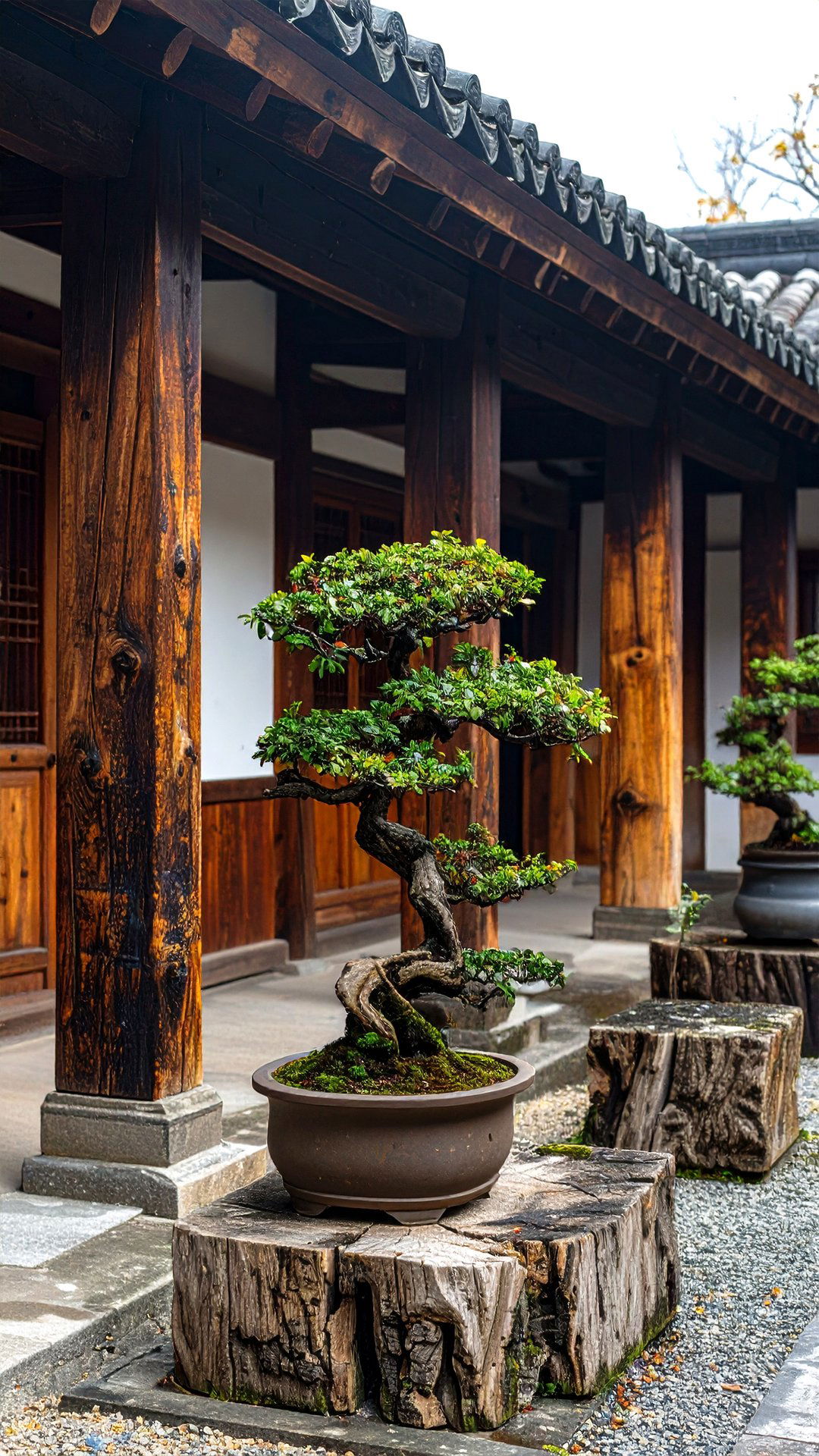
Salvaged railway sleepers or old pier posts cut into one-meter sections make charming pedestals when planed and oiled. Cracks, bolt holes, and charred edges provide wabi-sabi charm, emphasizing bonsai themes of impermanence. Set pillars on leveled concrete pads spaced roughly two meters apart, alternating heights for rhythmic flow. Cap each with a recessed aluminum disk matching the pot diameter to deter rot where wood meets ceramic. Over time, fungi may spot surfaces; scrub gently with a stainless-steel brush to retain texture without deep gouging.
16. Cliffside Rock Plantings Create Dramatic Verticality

Styling a tree clinging to a vertical slab — known as Ishitsuki — evokes alpine precipices in miniature. Select porous lava rock with natural pockets and drill extra holes if needed for anchoring wire. Pack cavities with akadama and sphagnum mix, then thread flexible species like Chinese elm through crevices. Mist several times daily until roots colonize stone surfaces. Display cliffside compositions on taller stands so viewers see the dramatic drop beneath the root mass. Winter cold can fissure rock, so move plantings under cover during heavy freezes to prevent splitting.
17. A Mini Torii Gate Marks a Symbolic Threshold
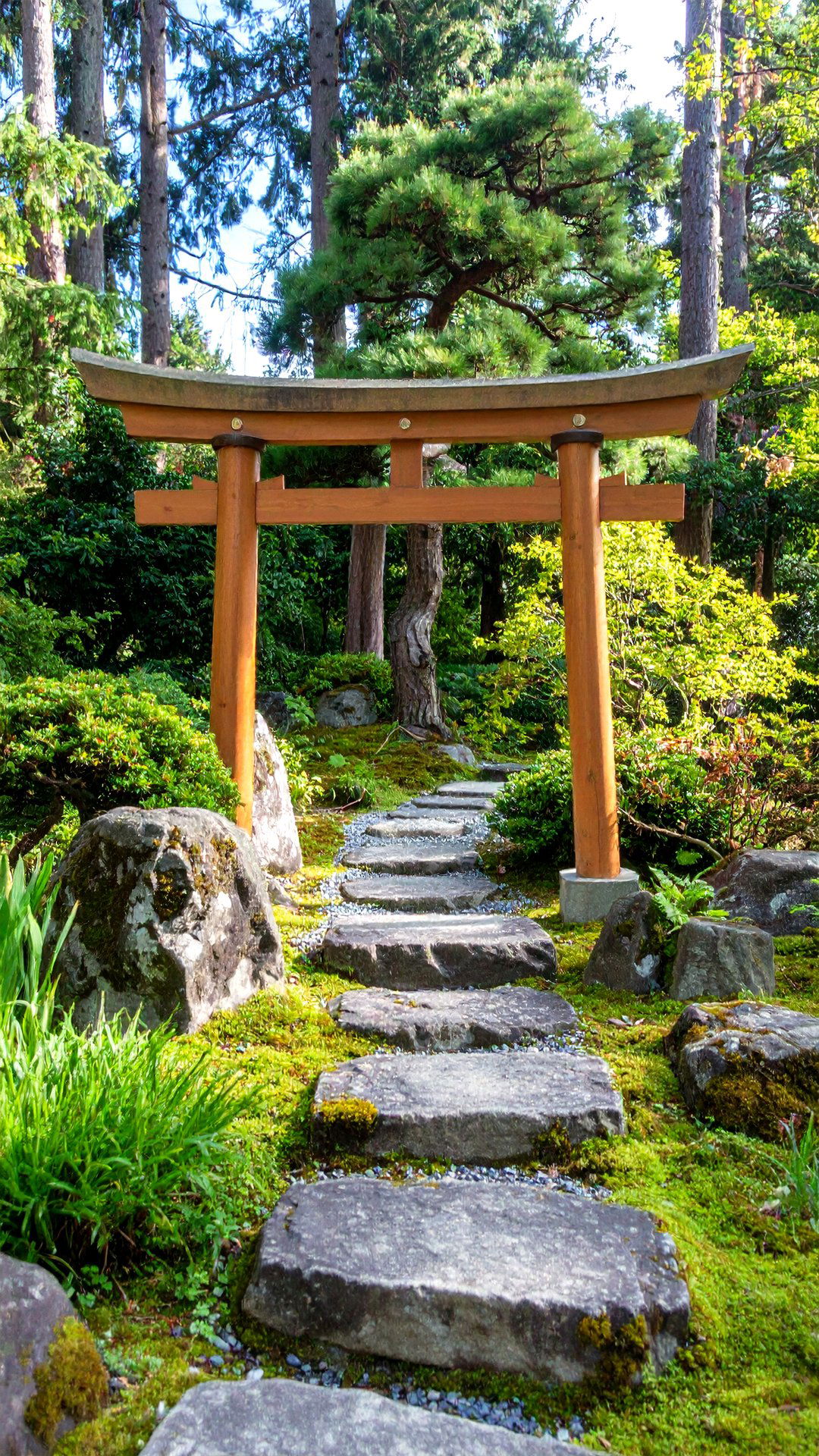
Adding a knee-high torii gate at the entry to a bonsai alcove signals a shift from everyday bustle to reflective space. Build the arch from rot-proof cedar painted vermilion or leave it natural for subtlety. The cross-beam’s upward flair frames trees beyond like a living painting. Align the gate precisely with a central focal tree, guiding sightlines inward. Keep proportions modest; an oversized structure overwhelms dwarfed trunks. Wipe dirt splashes after storms to preserve clean lines, and replace any cracked mortise joints before they loosen.
18. Micro-Forest Plantings Capture Woodland Ecology in Miniature

Rather than spotlighting single specimens, assemble five to eleven saplings of the same species — beech or trident maple excel — into a tray to depict an entire grove. Vary trunk diameters and heights to mimic natural succession, placing thicker “parent” trees off-center for asymmetry. Spread fine moss between trunks, leaving subtle clearings that read as meadows. Situate the forest on a low stand so the viewer peers across, not down, at the canopy, enhancing immersion. Prune peripheral branches lightly; too much density obscures individual silhouettes and starves interior foliage of light.
19. A Cascading Waterfall Stand Showcases Trailing Styles

For cascade or semi-cascade bonsai like juniper rigida, a tiered waterfall stand functions as both pedestal and thematic extension. Construct the frame from stainless steel rebars bent into zigzag incline, cladding surfaces with slate tile for authenticity. The highest point holds the pot, while lower ledges present collected stones to hint at falling water. Plant ferns in crevices at the base for splash-zone realism. Ensure the structure’s center of gravity remains over a broad granite base to cancel top-heavy wobble. Annual inspections confirm weld integrity against corrosion.
20. A Shade Pergola Protects Delicate Broadleaves
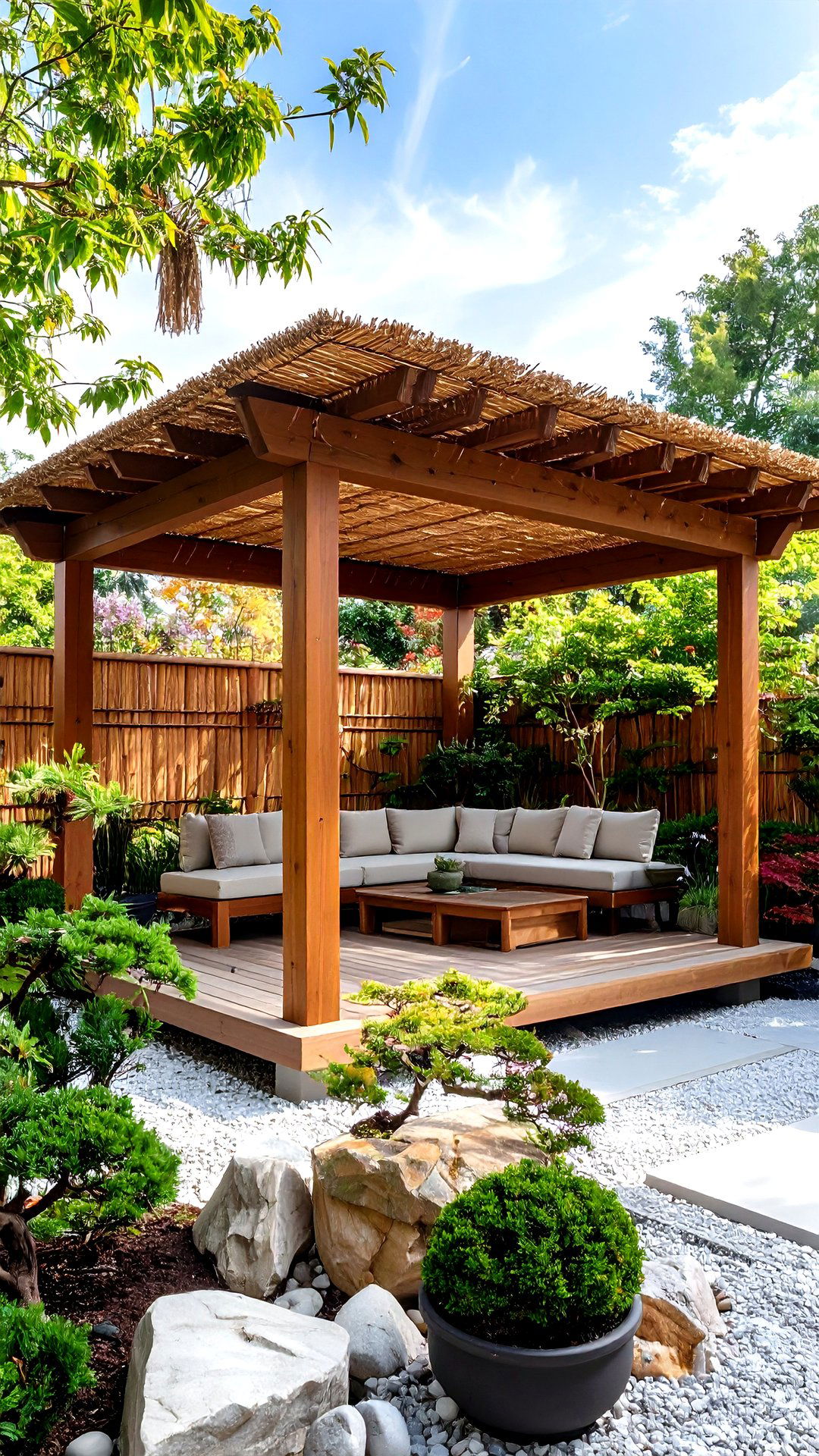
Broadleaved bonsai such as fukien tea scorch easily under midday sun, so a pergola topped with reed matting offers filtered light without blocking breezes. Angle the roof slats along the east-west axis to cast deeper shade at noon and gentler dappled light in mornings and evenings. Replace reed every two years as fibers become brittle. Suspend lightweight terracotta pots from overhead joists to add vertical layers, carefully balancing weight to avoid twisting beams. Rain still penetrates, preserving natural watering rhythms while preventing leaf burn.
21. Hanging Bonsai in Macramé Slings Adds Airy Height
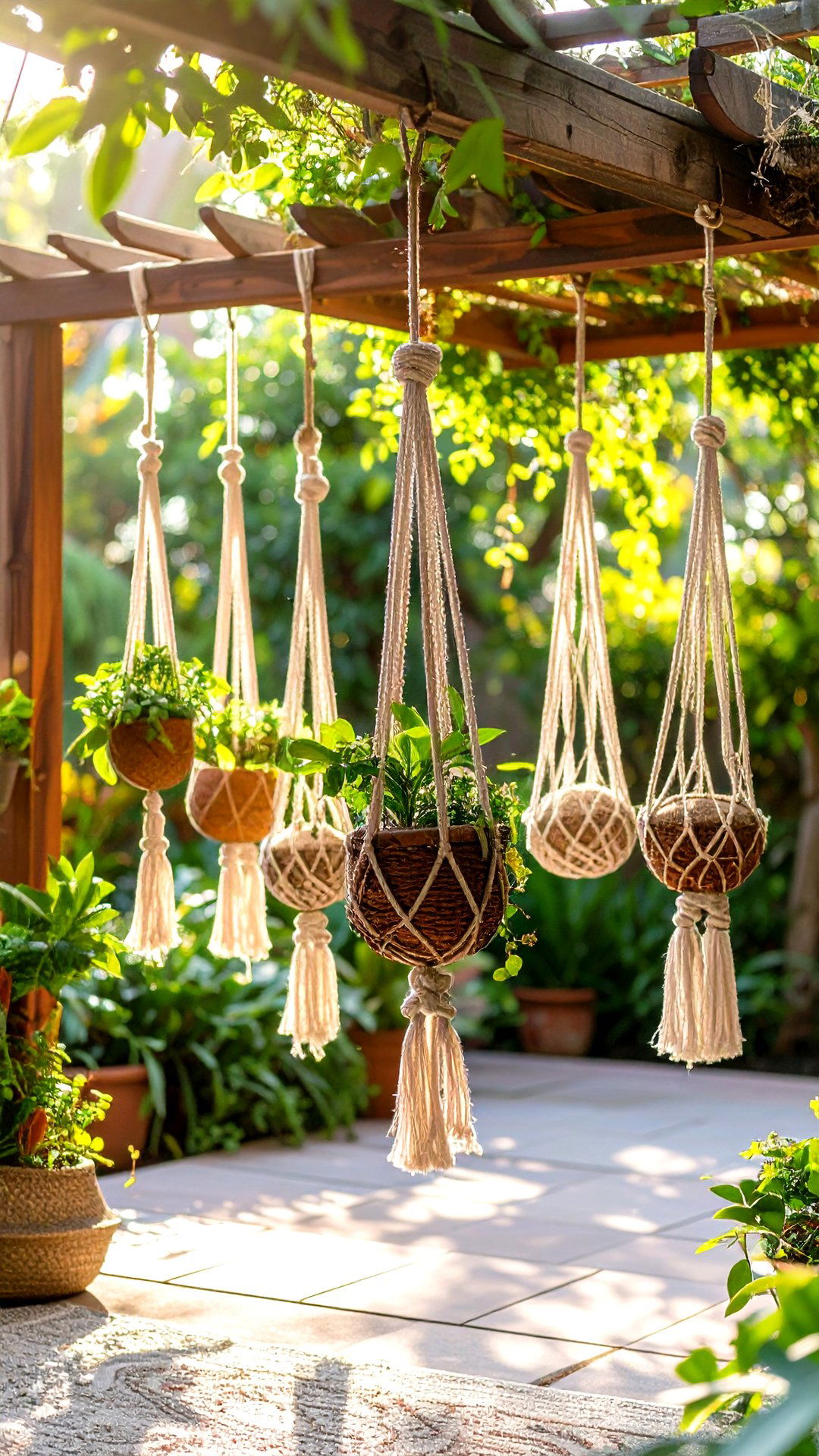
Experimental growers sometimes adapt kokedama techniques, suspending small ficus or serissa in sphagnum-wrapped soil balls cradled by macramé cords. Hang these living ornaments under tree branches or pergola beams where airflow abounds but midday sun remains tempered. Weekly immersion watering prevents surface desiccation; let excess drip before rehanging to avoid staining decking. Rotate plants 180 degrees each month so foliage grows evenly. Use polyester cord rather than cotton to resist mildew, and check knots seasonally for fraying that might dump precious trees unceremoniously.
22. Succulent Understories Offer Textural Contrast
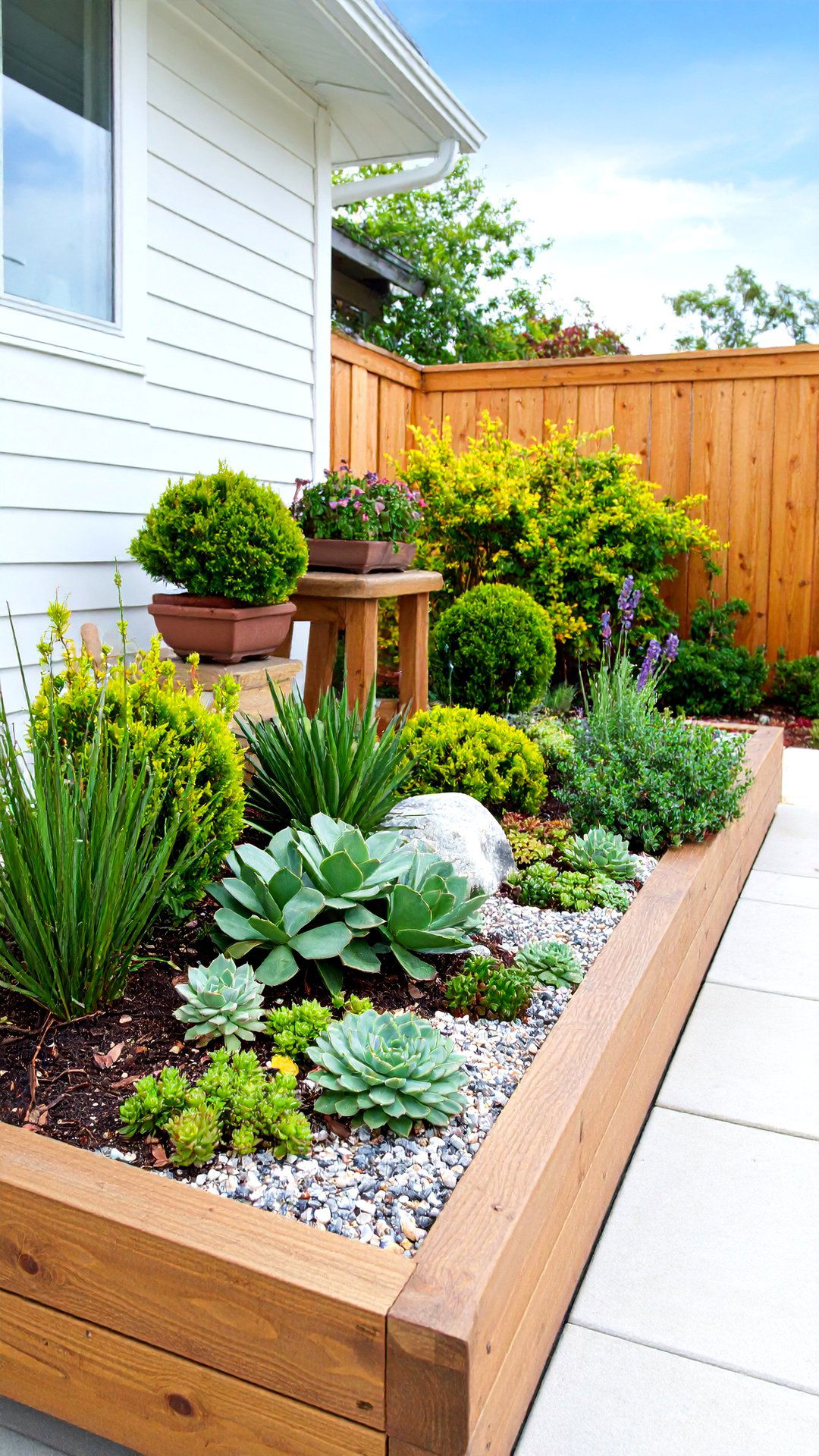
Planting low-growing succulents such as Sedum or Haworthia in trays beneath bonsai benches delivers a tapestry of contrasting forms while absorbing extra water runoff. The drought-loving rosettes thrive on the same sunny exposure many conifers demand, reducing wasted space. Opt for varieties that stay under five centimeters tall so they never compete visually with the hero trees above. Top-dress with crushed granite to blend soils visually and prevent rot. Remove any over-eager pups that creep toward bonsai pot roots, keeping layers distinct yet harmonious.
23. Color-Coded Pots Communicate Care Levels at a Glance
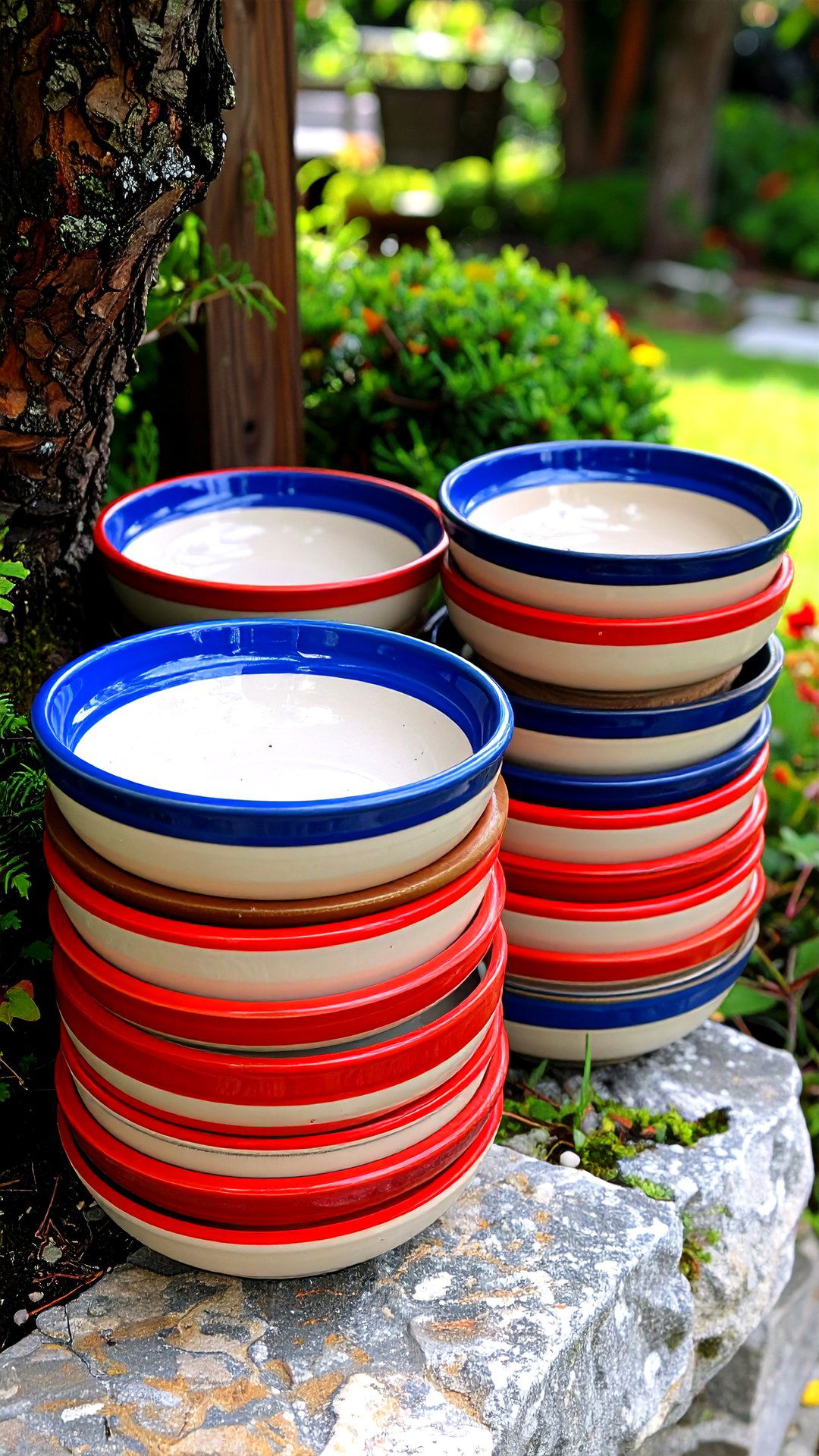
Managing dozens of trees can get complex; painting subtle color stripes on rear pot rims flags watering frequency or fertilizing cycles. For instance, blue stripes indicate high moisture species like bald cypress, while red means drought-tolerant juniper. The system lets helpers step in confidently when you travel. Use fade-resistant exterior acrylic, applying tape stencils for neat edges. Keep marks discreet from the front view to preserve aesthetic purity. Update a legend card stored in a weatherproof box nearby, revising as horticultural needs change through the seasons.
24. Smart Drip Irrigation Keeps Collections Hydrated Effortlessly
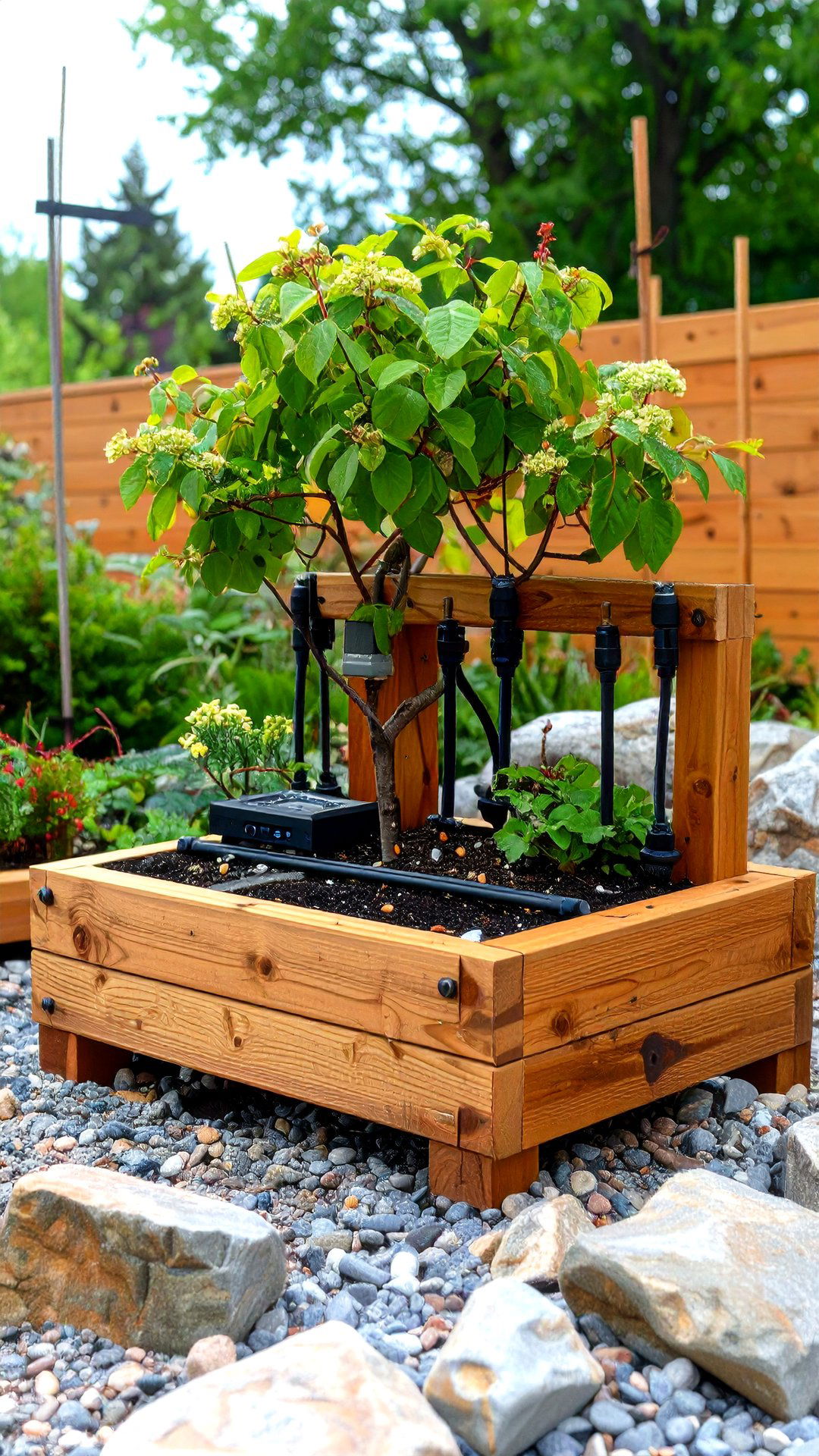
A programmable drip system frees you from hand watering during scorching Karachi summers. Run half-inch poly tubing behind stands, branching to micro emitters staked in each pot. Choose adjustable two-liter-per-hour drippers for precise control, and pair the manifold with a Wi-Fi controller that syncs to local weather forecasts. Pause cycles automatically after rain to prevent over-watering — a common bonsai killer. Flush lines monthly to clear sediment, and replace sun-cracked tubing every three years. Backup with a battery-powered timer so settings survive power cuts.
25. A Kids’ Learning Zone Inspires the Next Generation
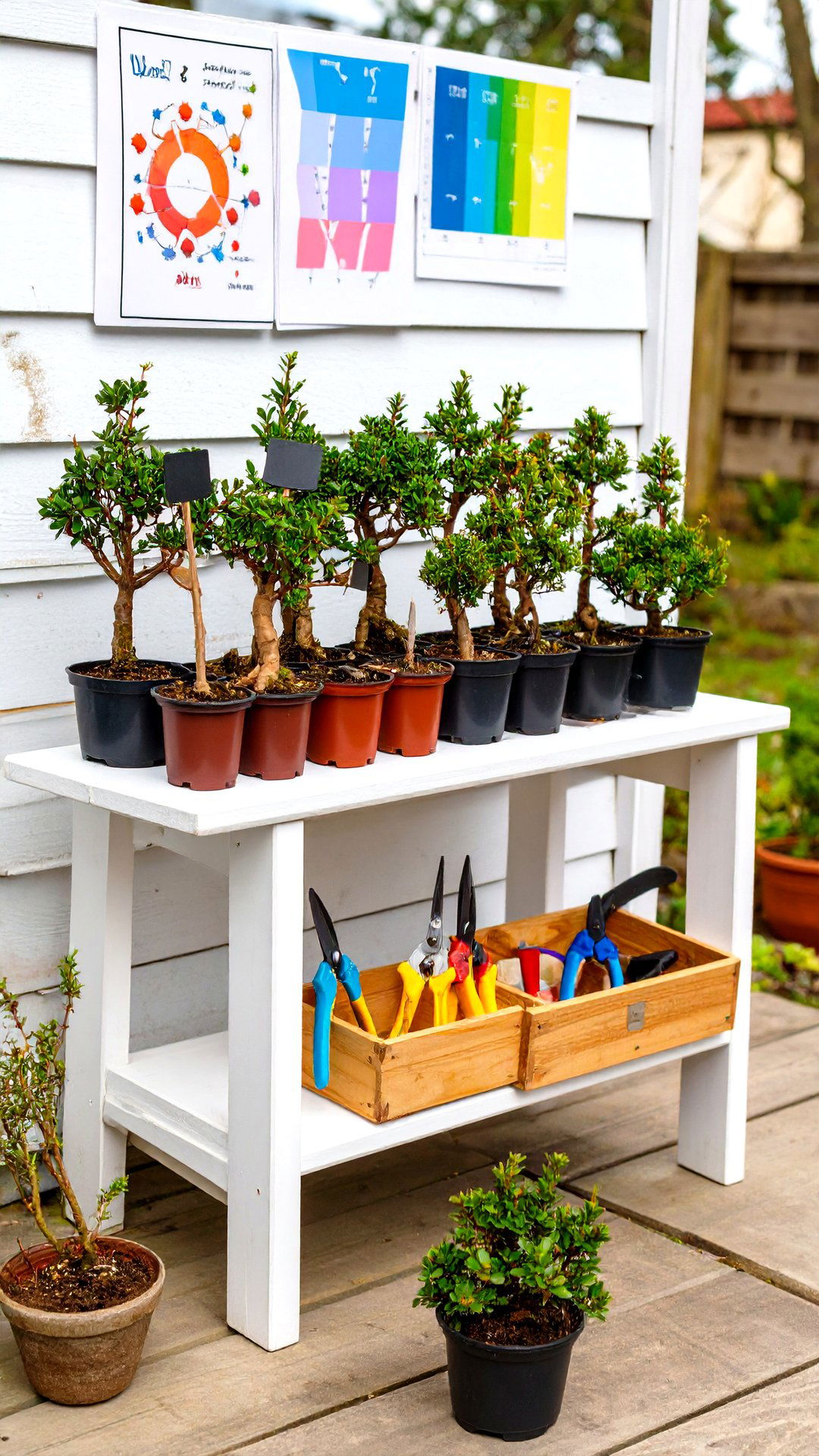
Dedicate one bench at child-friendly height to hardy starter trees like dwarf jade or portulacaria to spark curiosity. Provide blunt-tipped scissors for supervised trimming sessions, and mark progress on a growth chart so youngsters see tangible results from patience. Encourage them to name their trees and keep simple journals noting watering dates and bud bursts. Integrate colorful storyboards explaining how wiring shapes branches and why root pruning keeps trees petite. This hands-on corner plants seeds of environmental stewardship and ensures the art of bonsai flourishes long after our own collections mature.
Conclusion:
A bonsai garden proves that even a courtyard can echo mist-clad mountains, tidal cliffs, and ancient forests — if you sculpt each detail with intention. From sturdy tiered benches to whispering bamboo screens, every idea above invites you to blend horticulture, design, and mindfulness in one living canvas. Choose the concepts that resonate with your space and climate, then refine them season by season while the trees teach patience and proportion. In time, the garden will reward you not only with aesthetic beauty but with daily moments of calm, connection, and quiet joy under miniature canopies.


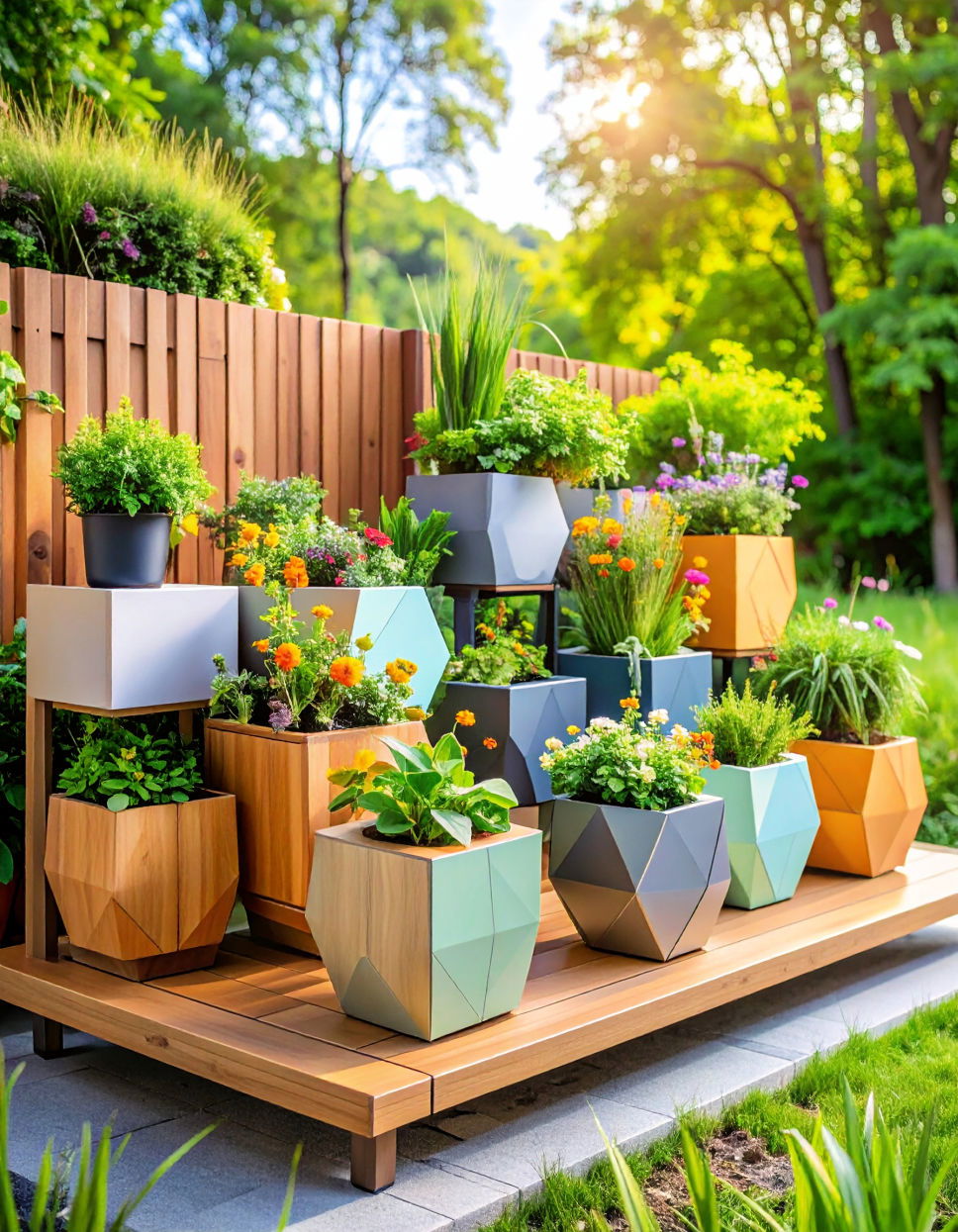
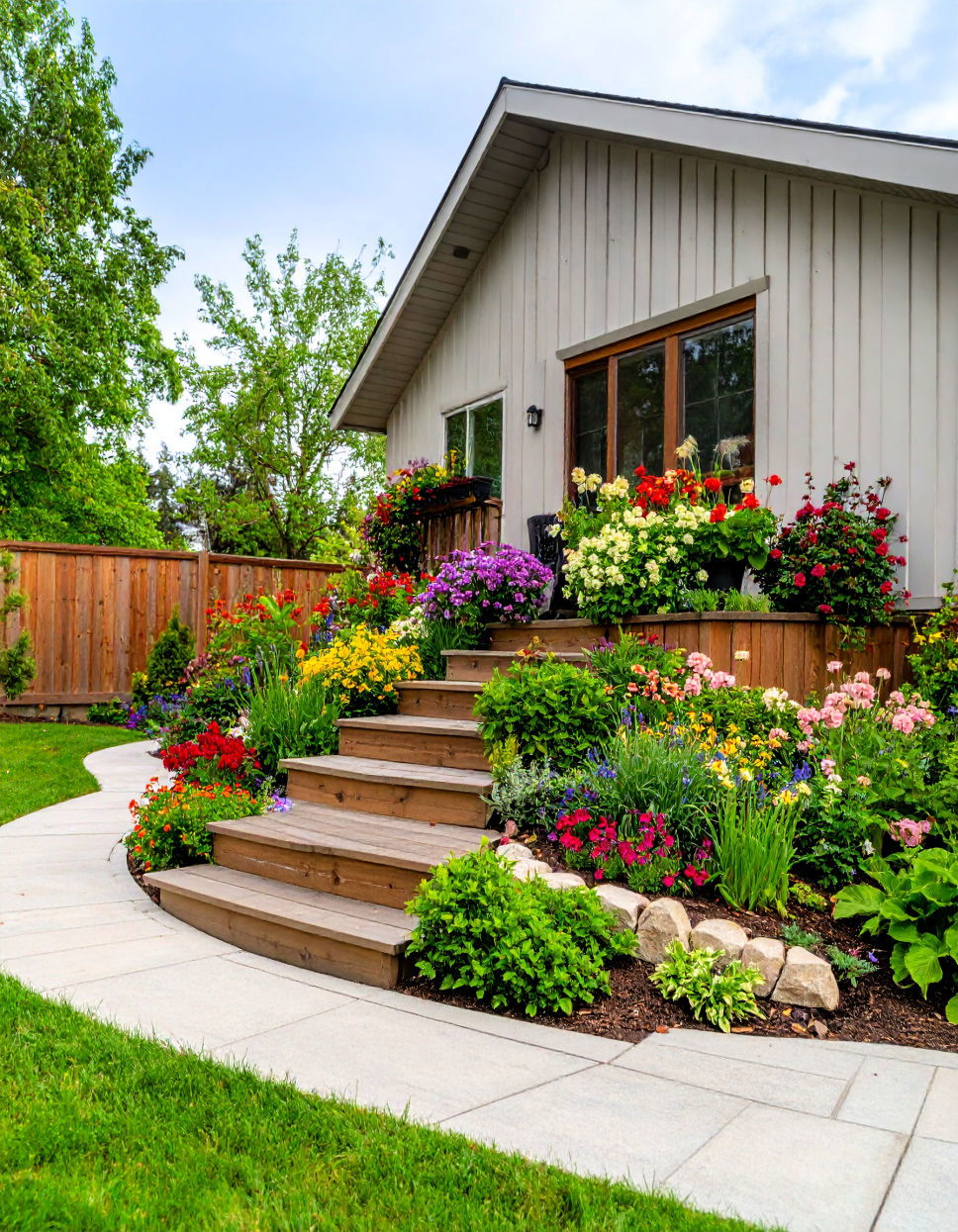
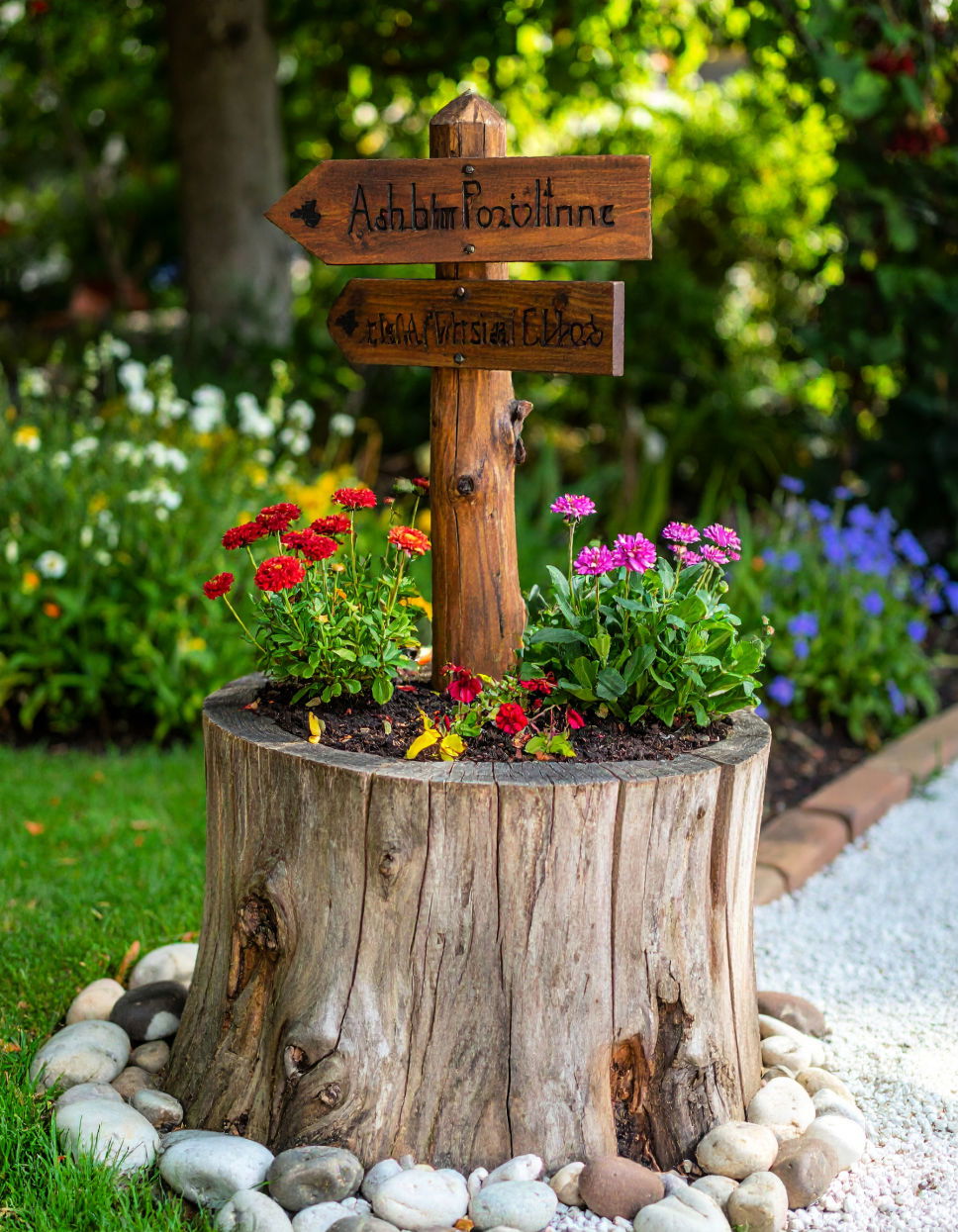
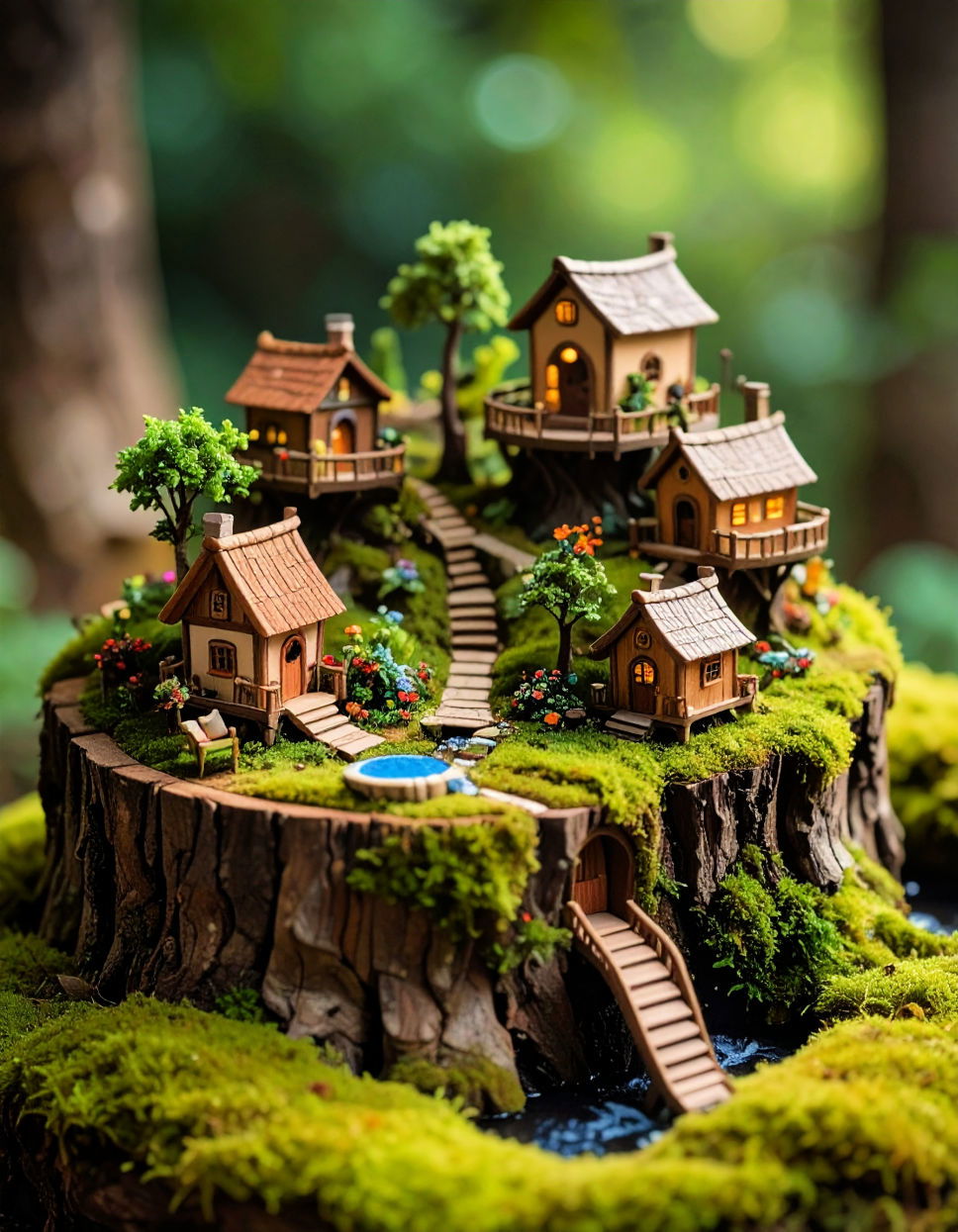
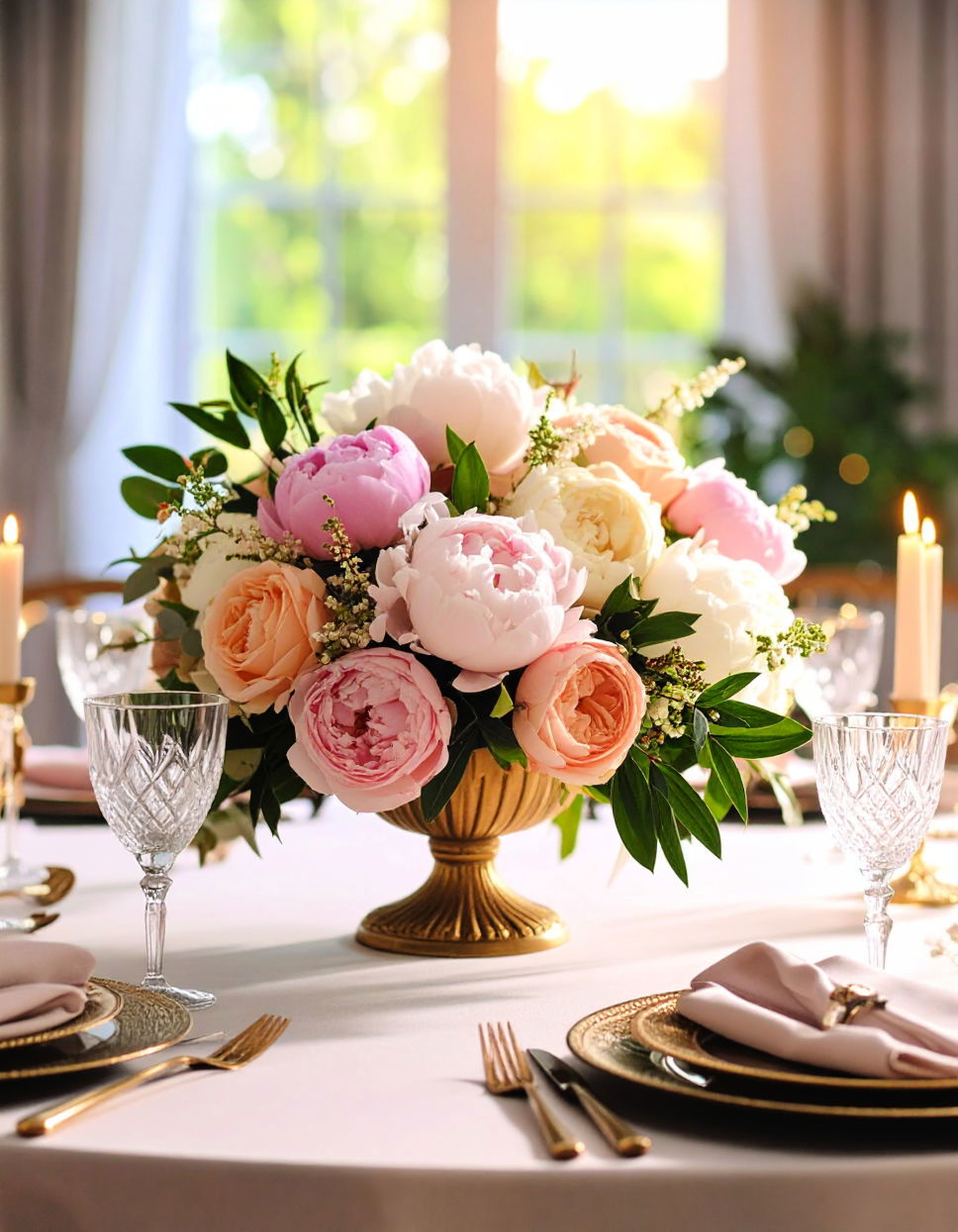
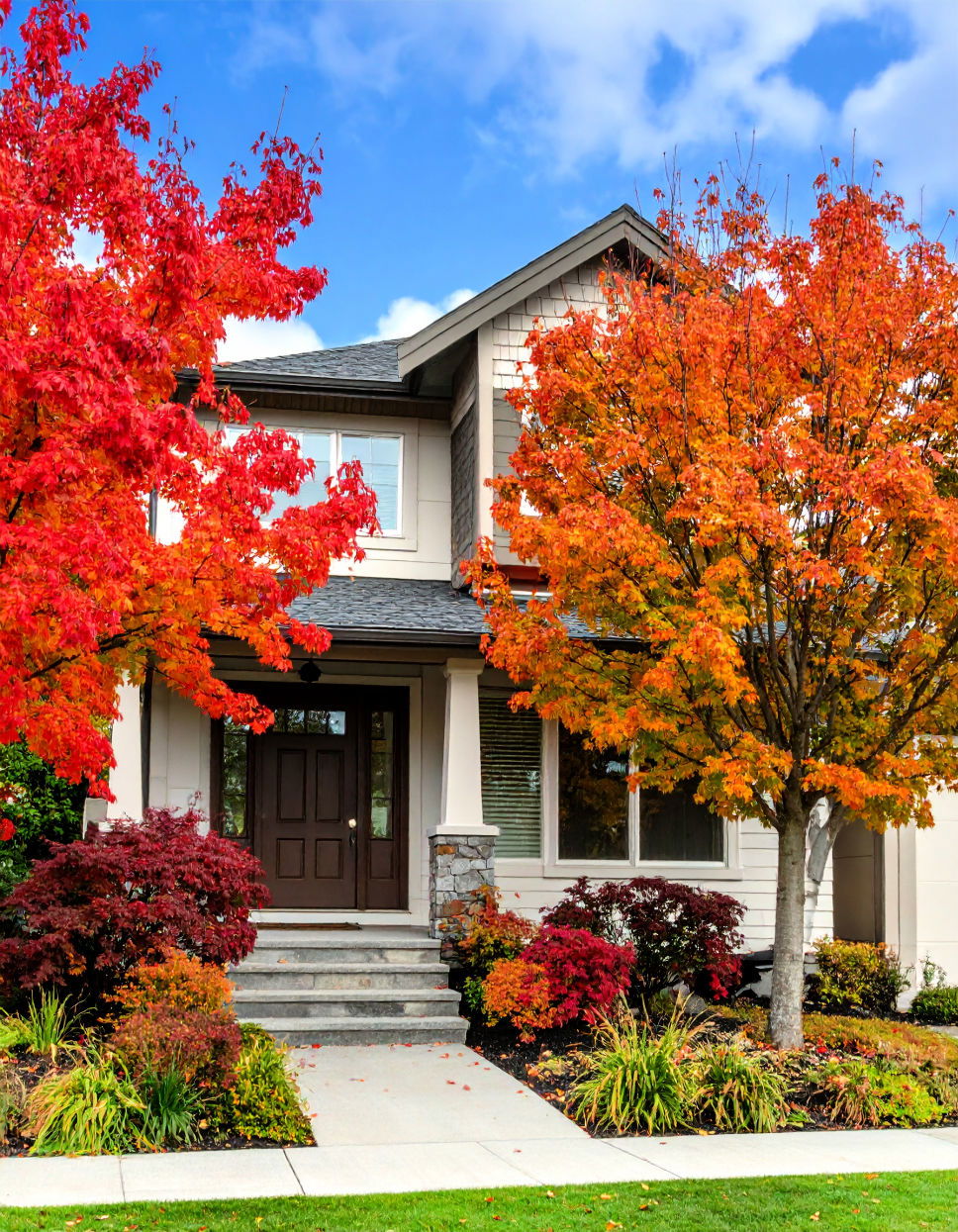
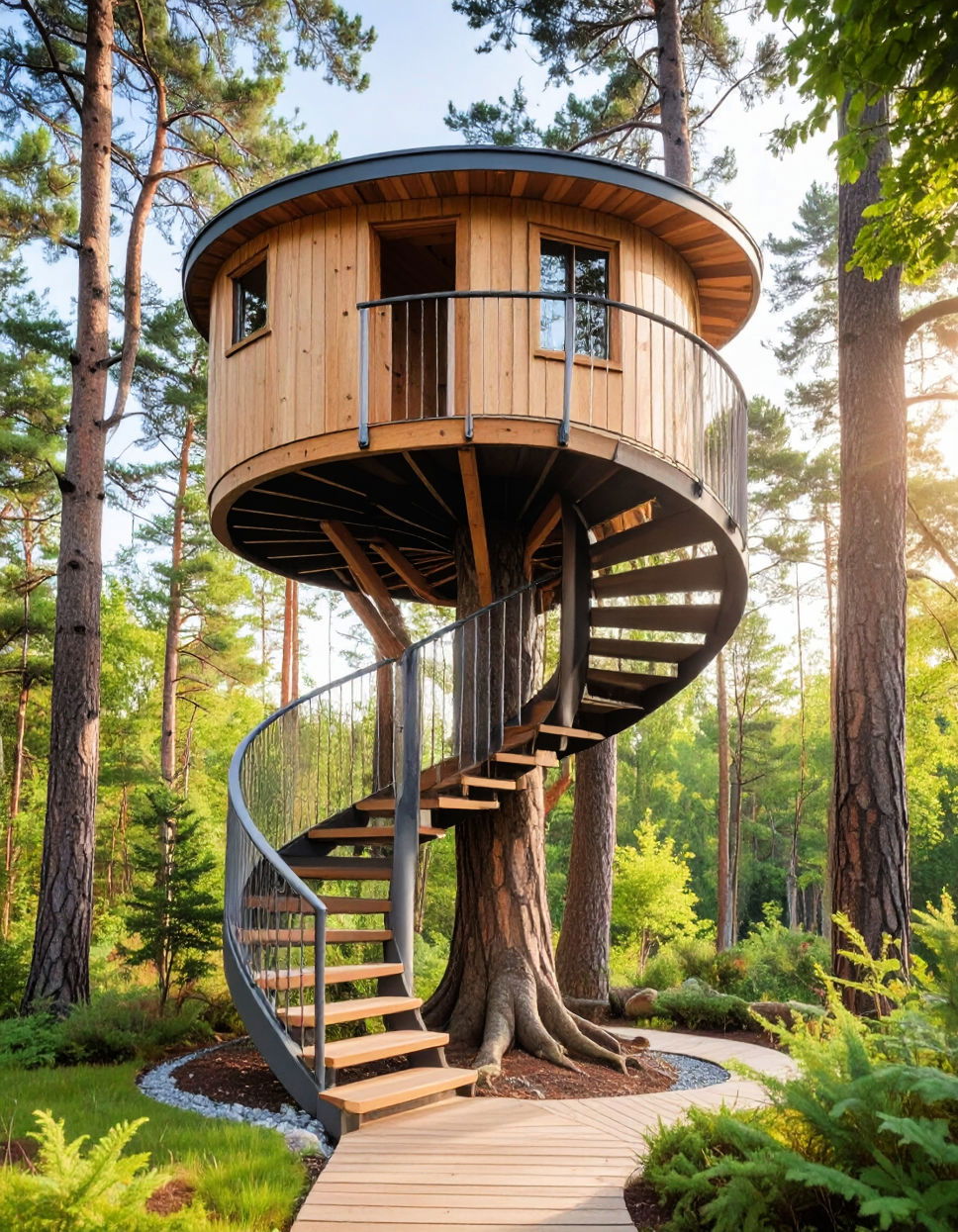


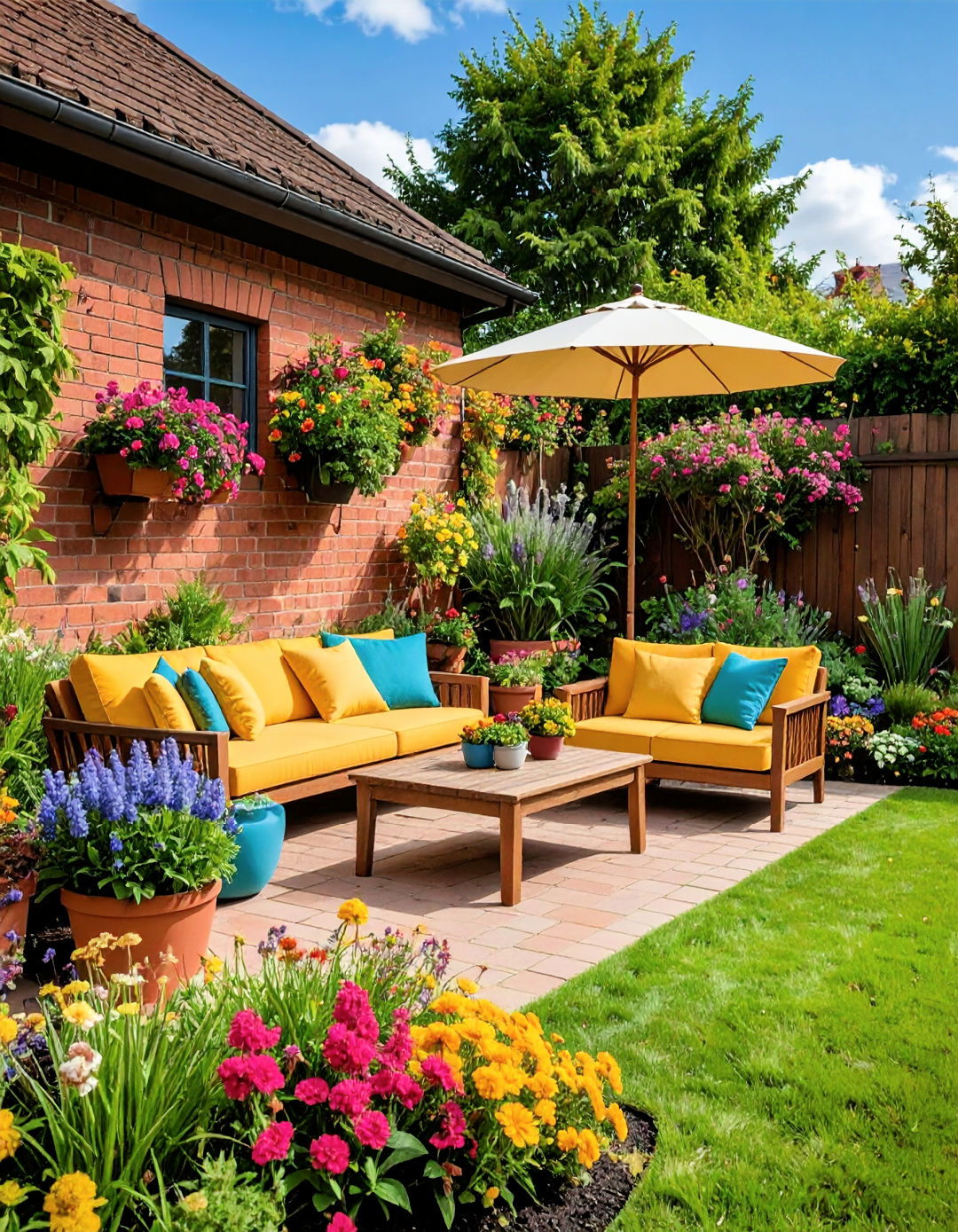



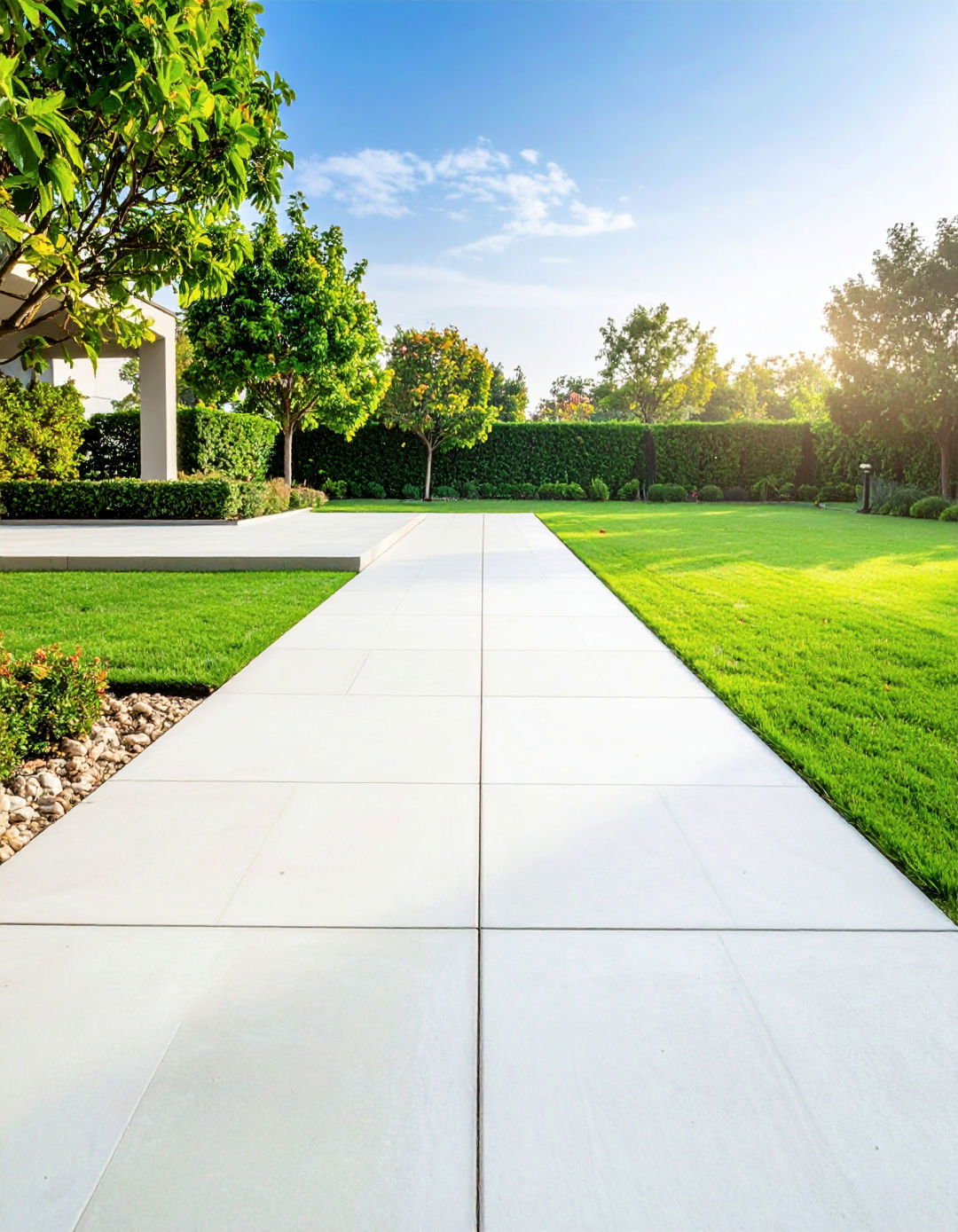
Leave a Reply